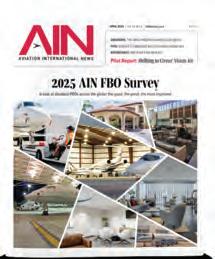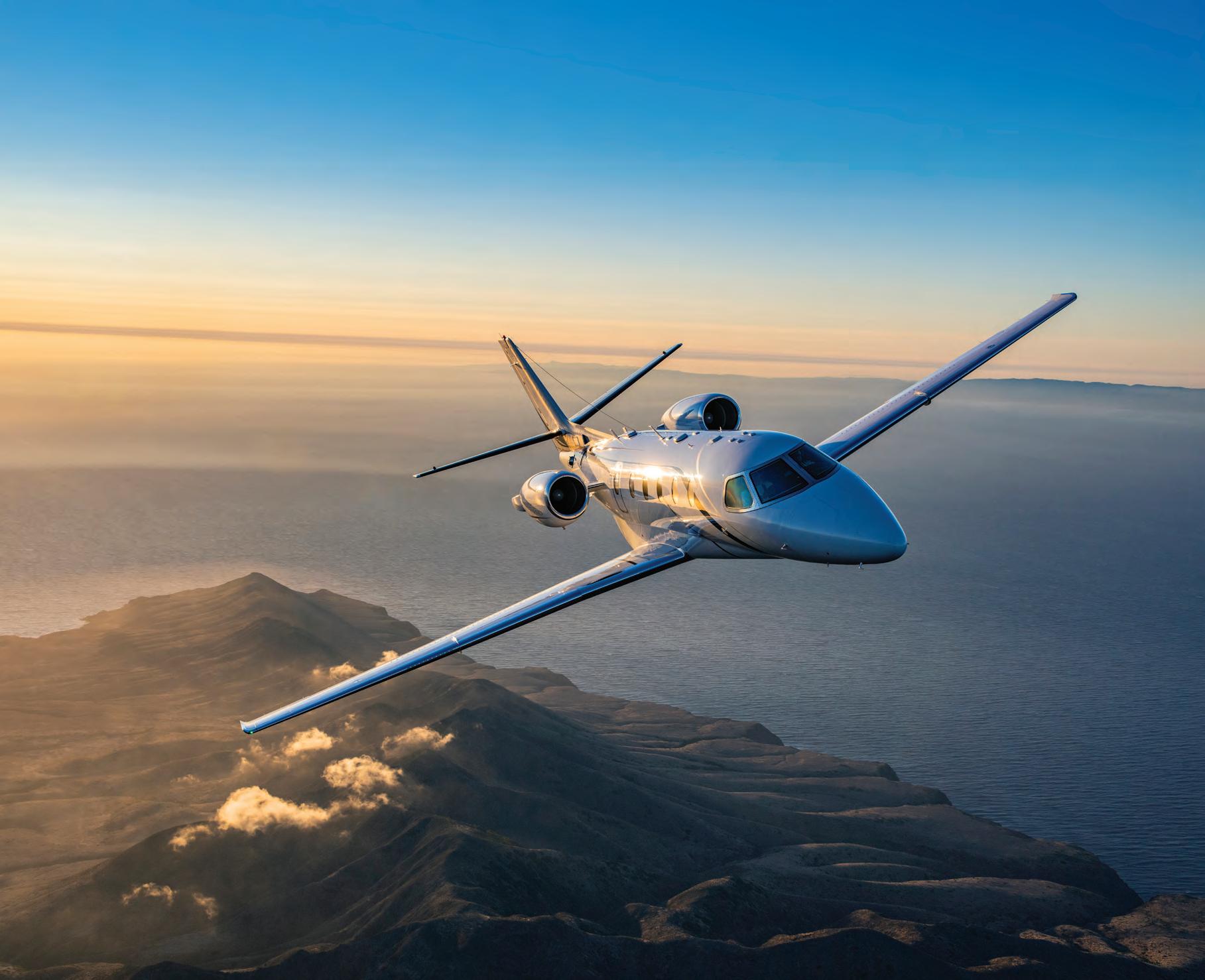
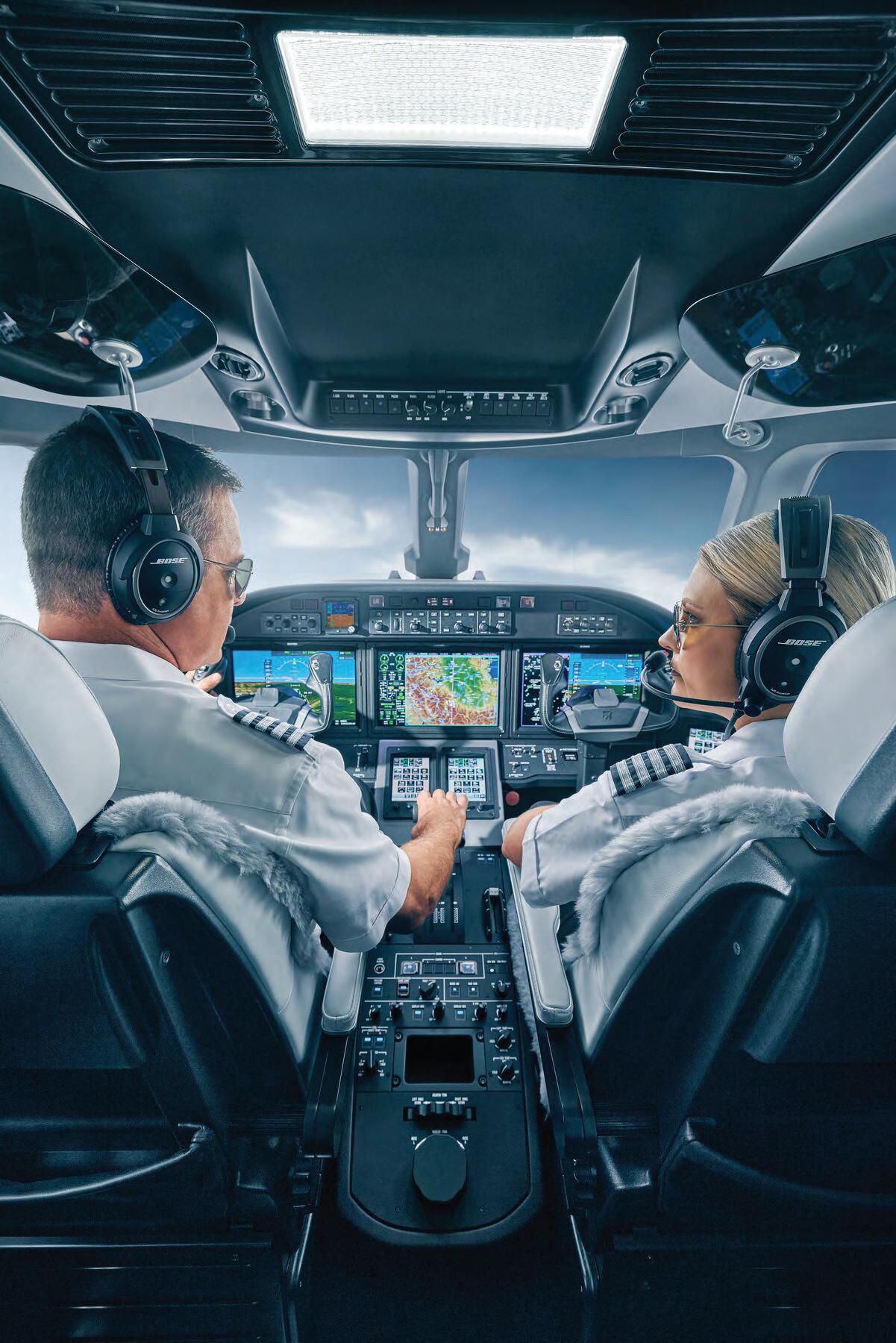

ASCEND DESCENDS AT NBAA STATIC
The Cessna Citation Ascend landed yesterday morning at Henderson Executive Airport, where the latest variant of the Citation Excel/XLS series will be on view at the NBAA-BACE static display. (Formore,seepage2.)




ASCEND DESCENDS AT NBAA STATIC
The Cessna Citation Ascend landed yesterday morning at Henderson Executive Airport, where the latest variant of the Citation Excel/XLS series will be on view at the NBAA-BACE static display. (Formore,seepage2.)
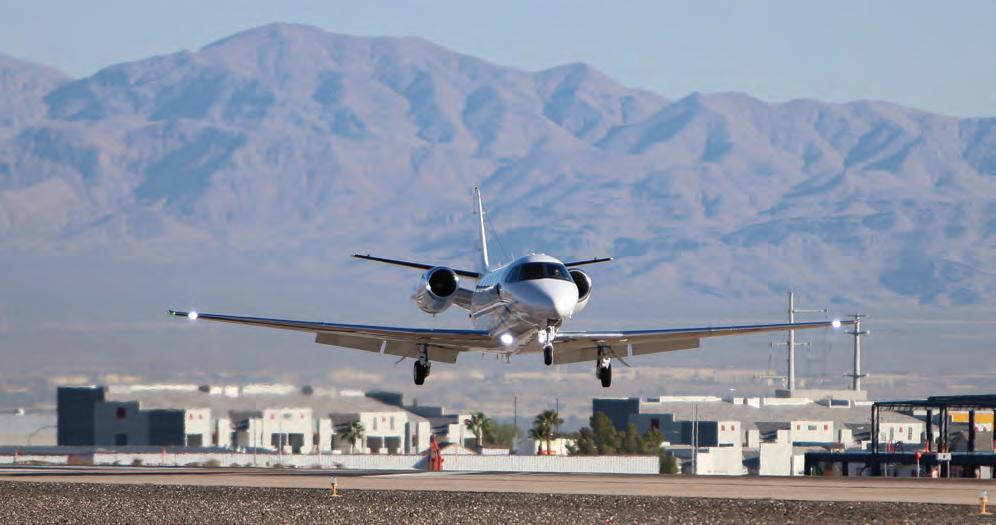
By Kerry Lynch
Bombardier is throwing down the gauntlet for business jet speed, establishing Mach 0.95 as the Mmo (maximum Mach operating number) for its Global 8000, the company announced on yesterday at NBAA-BACE 2025. Up from the previous target of Mach 0.94, the new Mmo will be the highest approved for a subsonic civil aircraft and the fastest for a business jet in history.
“Today will mark a turning point in the way we travel the world,” Bombardier president and CEO Éric Martel said as Bombardier revealed the increased Mmo. “Travel isn’t just about reaching a destination. It’s about making the most of every moment in the journey, and it’s about chasing the next time.”
A Mach 0.95 top speed will enable operators to more readily fly at faster speeds without pushing the Mmo limit and maintain range, explained Stephen McCullough, senior v-p of engineering and product development for Bombardier.
This could also mean a 7% improvement on a typical flight between New York and London. “For the operators of these aircraft, every minute counts,” McCullough said.
“The Global 8000 was already the fastest business aircraft ever built, and with this new speed capability, this incredible aircraft is set to redefine the ultra-long-range market,” McCullough added.
The move to Mach 0.95 began the year before the Global 8000 was formally launched, when Bombardier flew the flight-test vehicle beyond the speed of sound. “When we did that, we realized that the aircraft handling capability was actually better than 0.94,” McCullough explained.
Even so, the company originally locked down Mach 0.94, a number that the company knew it could commit to with customers. “But the team at Bombardier, which really is constantly innovating, looked at how do we do this? This is different than what we’ve seen in the industry,” he said.
About two years ago, McCullough continued, Bombardier went back into the wind tunnel to test the model at speeds as high as Mach 1.2.
10-YEAR FORECAST
Revenue growth ahead
Honeywell predicts 8,500 bizjet deliveries over the next decade | 06
BIZAV VENTURE
Real Jet takes off Kenny Dichter’s latest creation is a boutique air charter brokerage | 08
SUPER-MIDSIZE
Gulfstream G300
The aircraft features a longer cabin and 10 panoramic windows | 10
MARKET VOLATILITY
JetNet’s forecast
Demand signals remain strong for bizjets, with an estimated 820 jet deliveries this year | 28
By Kerry Lynch
Textron Aviation is debuting the Cessna Citation Ascend this week at NBAA-BACE 2025, showcasing the latest edition of the venerable Excel/XLS as the midsize jet is on the cusp of FAA certification. This debut also comes a month after Textron Aviation rolled out the first production Ascend at its facilities in Wichita.
Launched at EBACE 2023, the Ascend first flew in June last year. Since then, two test articles have amassed more than 1,000 flight test hours. Certification is anticipated this year, with NetJets set as the launch customer under a multi-year 1,500-aircraft contract for the Citation Longitude, Latitude, and Ascend. Replacing the XLS Gen2 after its anticipated approval this year, the Ascend is the next step
in a product line that has numbered more than 1,000 deliveries since 2000.
Significantly, the Ascend is the first to offer a flat floor in the Excel/XLS line and borrows design features from Cessna’s super-midsize Longitude and midsize Latitude. Like its larger siblings, the Ascend features Garmin G5000 avionics with autothrottles—a change from the XLS+’s Collins Pro Line 21 system and completing the transition to Garmin avionics across the entire Citation product line.
Also new with the Ascend is a full-size airstair, an externally serviceable lavatory, single-point refueling, and an upgraded Honeywell RE100 (XL) auxiliary power unit. In addition, the aircraft cabin will be equipped with 19 USB charging ports and three universal power outlets.
The Ascend is offered with the Gogo Galileo HDX as an option, providing connectivity for multiple devices that require heavier data applications such as streaming. During a media flight aboard the Ascend ahead of NBAA-BACE, the Gogo system highlighted seamless use and fast processing.
“We asked our customers what they wanted in this iconic aircraft, and our teams worked to bring their vision for the Citation Ascend to life,” said Lannie O’Bannion, senior v-p of sales and marketing. “Visitors can see the new Garmin G5000 cockpit and experience the sleek new interior features, including a flat floor, larger windows, and wireless cabin management system.”
O’Bannion noted that, as a result of the changes, “We’ve created a totally different experience for our customers.” z
Safety, innovation, and future-oriented initiatives were the forefront of the 2025 NBAABACE Newsmakers Luncheon yesterday.
Congressman Sam Graves (R-Missouri) emphasized the importance of compromise in keeping aviation legislation bipartisan.
“The FAA reauthorization was just a shining example of the things that you can get done when you work with the other side,” he said. “Rick [Larsen] and I believe in old-school politics. That means we believe in compromise. It’s not all or nothing.”
Graves also said he is pleased with the down payment on the air tra c control modernization. “Transportation Secretary Du y is absolutely committed to making sure that this finally happens,” he said. “The administrator, the FAA wants to have it done within 3.5 years. We’ve got to do some permanent reform to be able to get that done. But I do believe we can meet that challenge, and we can meet that goal.”
NBAA president and CEO Ed Bolen reminded the audience that when it comes to advancing aviation, people behind the industry are key. “It’s about the people,” he said. “Always, people first.”
NATCA president Nick Daniels made an impassioned appeal to the aviation community on behalf of the air tra c controllers who are working without pay due to the ongoing government shutdown. “With no end in sight, this strain is going to grow day by day,” he warned.
“Their last paycheck, a partial paycheck, is tomorrow. We’ll begin seeing an entirely new introduction of risk into this National Airspace System, starting now. Tomorrow, the nation’s air tra c controllers will face their first loss of income, and because of this shutdown.”
Key points highlighted by speakers included showcasing of advanced aerospace technologies, a new Tribute to Flight Pavilion featuring vintage aircraft at Henderson Airport, and the displayed Archer Midnight eVTOL.

Included on the business aviation industry panel were Ron Draper, president of Textron Aviation; Bombardier’s Éric Martel; Flexjet president Mike Silvestro; and Michael Amalfitano, president and CEO of Embraer Executive Jets, with moderation by CNBC’s Phil LeBeau. The panel discussed the robust and resilient state of the industry, driven by wealth creation and a 20% global wealth growth forecast by 2029. Key metrics include a 40% application rate and 1,000 Atlantic crossings by Flexjet. A.W.
The opening paragraph of our Gulfstream G300 launch story on page 10 incorrectly identifies the G280 derivative model’s cabin stretch length. It is actually a 2-foot stretch, as correctly noted later in the same story. AIN regrets the error.

Visit us at NBAA Booth #1533







By Curt Epstein
Business aviation OEMs are expected to deliver 8,500 business jets over the next decade, according to Honeywell Aerospace’s 34th annual industry forecast released on the eve of NBAA-BACE 2025. While that volume remains unchanged for the past four years as OEMs wrestled with post-Covid supply-chain recovery, the report predicts an increase in value to $283 billion for those aircraft, the highest dollar amount in the history of the survey. Of that amount, two-thirds of the value is expected to be on the large-jet side, according to Honeywell’s calculations.
“I would say starting in 2023 to 2024 and now this year, definitely we’re seeing improvements across all supply chains, ourselves definitely, and you see this in the actual output of OEMs too, where they’re increasing [deliveries],” said Kevin Schwab, strategic planning manager for Honeywell Aerospace. “If you look at OEM guidance, and how we’re doing so far this year in terms of deliveries, I think we’re actually kind of climbing out of this period and starting to deliver the amount of jets the industry needs.”
Honeywell’s annual forecast does not consider personal jets such as the Cirrus SF50 Vision Jet in its total. Excluding those, the company predicts 740 business jet deliveries this year, the highest tally since 2019.
For next year, the forecast calls for a 5% increase in deliveries over 2025. “In 2026, we’re expecting to be about 8% above [pre-pandemic] 2019 in terms of units, and because of the larger portion of large jets, now in 2026 we are expecting to be almost 25% up versus 2019 in terms of value of the aircraft that are being delivered,” Schwab told AIN
Since 2019, fractional operators have seen more than 65% growth, with their fleets now totaling roughly 1,300 aircraft. Demand for the segment has spurred the industry growth, led by the midsize and super-midsize business jet segments.
In the near-term of the forecast, the predicted mix of geographic locations for aircraft deliveries is 71% to North America, 14% to Europe, approximately 7% to Latin America, Asia-Pacific 5%, and 3% of jet deliveries will go to the Middle East and Africa. Schwab noted that North America will account for 69% of the aircraft value due to its more diverse fleet.
“There’s a higher portion of what I would call regional travel, so the value of the jets that are being delivered to North America is a bit lower than the units, and this is just because we’ve got more light jets, basically,” he explained.
That contrasts with regions such as AsiaPacific and the Middle East, which are expected to account for higher percentages of large jets in their mix due to geography
and their distance to world financial centers.
For the 10-year forecast window, Honeywell anticipates an average 3% annual growth, with the market split fairly evenly between small, midsize, and large-cabin/ultra-long-range jets.
It does not see a return to the heady preglobal financial meltdown era and its more than 1,300 aircraft deliveries in 2008, but it does see steady growth, particularly reaching into the 2030s. “What we are expecting to happen in the latter term of our forecast is to get closer to that number and then be sustained,” said Schwab. “While we may not get to the peak of where we were, we suspect we will get to about 900 aircraft a year, and that will be the new normal, and then you will have growth on top of that.”
As part of its annual forecast, Honeywell interviewed several hundred business aircraft operators. When asked about their market confidence, 91% of respondents stated they expect to fly at least the same amount as they did this year, if not more.
One-fifth of all survey respondents indicated they have at least one aircraft on firm order, while among the subset of Part 135 operators, that rose to 28% of survey respondents. The return of 100% bonus depreciation is expected to spur additional aircraft purchase activity in the U.S., according to Honeywell.
For new aircraft buyers, the survey found that customer support and technology are weighted more heavily in purchase decisions than they are for preowned aircraft.
This year’s survey marked the fifth in which sustainability was a key topic. Of those who indicated that they are taking steps to improve their environmental impact, 60% said they are acquiring more fuel-efficient aircraft, more than half are using sustainable aviation fuel, and nearly a third are flying at more efficient cruise speeds.
“The combination of recent economic growth, increasing demand for fractional ownership, and a steady cadence of new aircraft development and technology upgrades has produced record levels of demand in business aviation,” said Heath Patrick, Honeywell Aerospace Technologies president for Americas aftermarket, summing up this year’s results.
“Over the next decade, we expect these record-setting levels of deliveries and usage to continue,” he concluded. z
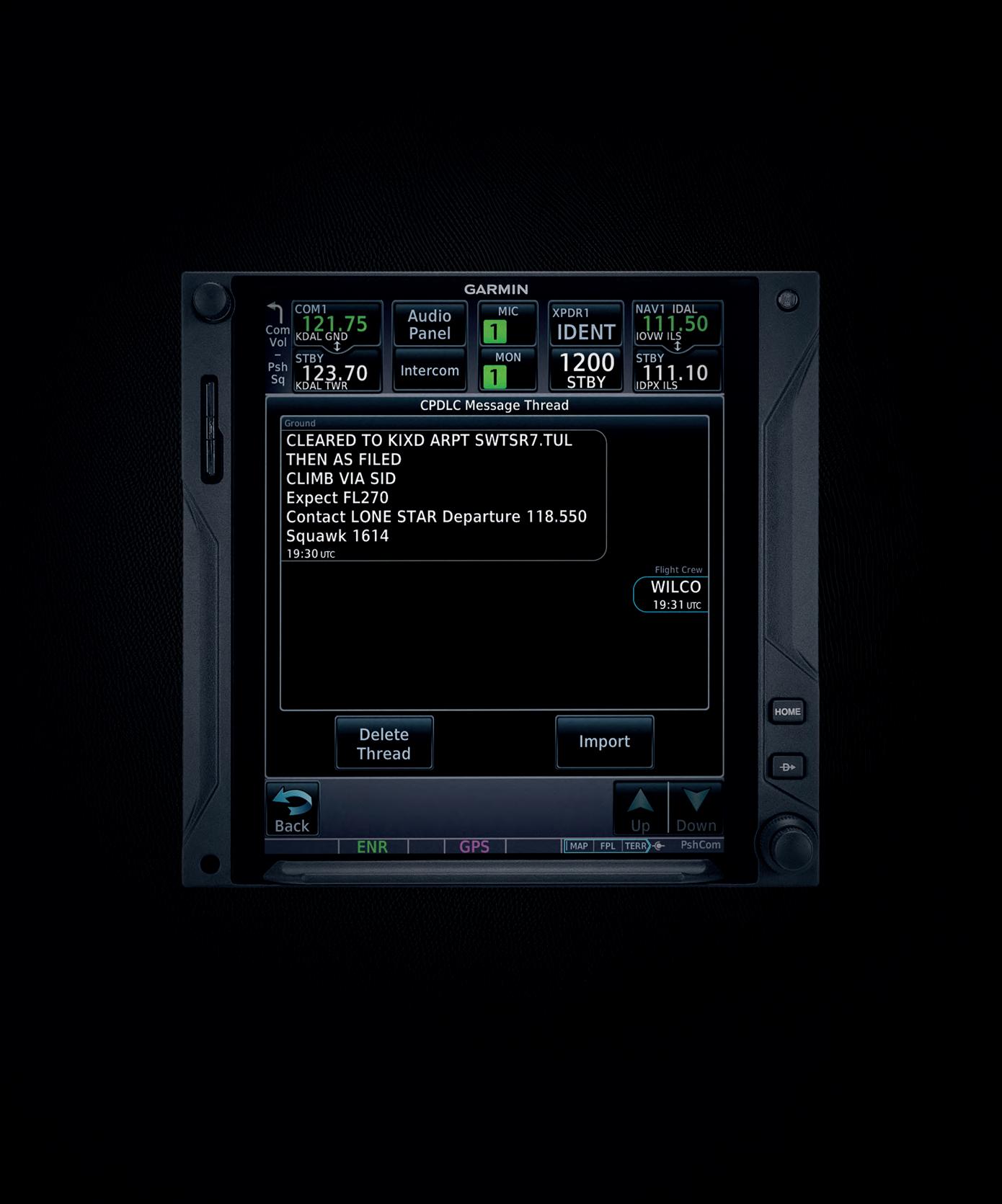
VOICE CALLS AND READBACKS AREN’T ALWAYS CLEAR. UPGRADE TO FAA DATA COMM FOR TEXT-BASED ATC CLEARANCES. AVAILABLE NOW ON SELECT GTN ™ X i AND TX i ™ EQUIPPED AIRCRAFT.
FOR A DEMO, SEE US AT NBAA EXHIBIT #2705
By Kerry Lynch
Business aviation entrepreneur Kenny Dichter returned to NBAA-BACE to highlight his next chapter as founder of Real Jet, reentering the air charter brokering realm but this time with a boutique approach that focuses on top-tier service. Speaking to reporters Monday at BACE, Dichter likened the new venture to models of the Four Seasons or Burgess Yachts—long-standing companies with strong reputations for high-end, white-glove-type service, but that are not asset-based.
Announced earlier this year, the corporate entity is headquartered in New York with the operational base in Atlanta. Launching operations in August, Real Jet already has about 30 people on staff and has arranged about the first 100 flights, most of which have sought out Real Jet service.
Real Jet builds on relationships that Dichter and his colleagues have established over the years—in fact, he founded the company with several of his colleagues from Wheels Up and Marquis Jet. The company is led by president Robert Withers, who has long worked with Dichter both as a co-founder of Wheels Up and at Marquis Jet—“a 40-year friend and a 20-plus-year partner.”
“We’re really fortunate to have 12 or 15 people that joined us from our past lives,” Dichter said. Withers, he added, has “tremendous good faith and credit with the operating community.”
Real Jet is offering a straight brokerage without jet cards, membership, or other feebased requirements for service. However, it is

building a Real SLX platform that creates an “ecosystem,” with hospitality, unique experiences, and other curated benefits, in addition to private aircraft options.
Real Jet differs from the past two companies Dichter founded: Wheels Up, a multifaceted operator and broker that aimed to democratize the business with broad growth, and Marquis Jet, which pioneered fractional jet cards. Wheels Up ultimately went public with Delta Air Lines becoming the largest shareowner, and fractional ownership provider NetJets acquired Marquis Jet.
But unlike Wheels Up, which became a billion-plus operator, Dichter and his partne r’s vision for Real Jet is to cultivate it into a $500 million to $750 million company over the next three to five years with a customer base of 5,000 to 10,000 people.
Likewise, the company plans to limit its charter placements to about the top 200 operators—ones that Real Jet executives know and have vetted, particularly on the safety front. But Dichter noted that many of the operators have long worked with the Real Jet team in their past roles. The Real Jet team is further meeting with operators at NBAA-BACE this week.
As far as service, Dichter said he’s taken lessons learned from the likes of fractional ownership pioneer Richard Santulli, the former NetJets chief who sold his service and then ultimately the entire company to Warren Buffett.
At Wheels Up, Dichter departed the company in 2023 as it was amid a reorganization and shoring up its debt. He noted the ongoing integration with Delta and said, “Both Robert and I are very proud of where Wheels Up is, but with Real Jet, there’s an
amazing niche—a boutique play in the market.”
Pointing to Burgess, Dichter noted that it has a 360-degree view of the customer. With Wheels Up and Marquis Jet, “I think about the 2 million takeoffs I think about the over $10 billion of sales [in two decades we created] and, in a lot of cases, new people to the industry, and I think about our retention rate of 90%. We have a high bar, but our new structure is where we are trying to have an incredible customer experience.”
He explained that this means customers remain at the center with full transparency and extensive communications. z Kenny Dichter the founder of both Marquis Jet and Wheels Up, is returning to his roots in his next venture: Real Jet, a botique air charter brokerage.
StandardAero completed supplemental type certificates (STCs) for both Gogo Galileo half- and full-duplex antenna installations on Bombardier 600-series Challengers. According to the company, this is the first time a completion center has simultaneously secured dual STCs for the HDX and FDX connectivity systems. The FAA approvals cover the Challenger 600, 601, 604, 605, and 650.
StandardAero completed the HDX installation on a Challenger 605 at its Springfield, Illinois facility at Abraham Lincoln Capital Airport, while the FDX installation was finished on a Challenger 604 at its Van Nuys, California location. J.R.
Elevate the safety of your flight operation. FlightSafety International (FSI) trains pilots beyond regulatory requirements, expertly preparing them for the challenging scenarios they will encounter. O ering courses for virtually every business aircraft, FSI empowers aviation’s most elite professionals with the skills required to safely transport passengers around the globe.

Learn about our comprehensive training solutions at NBAA-BACE booth 1545.
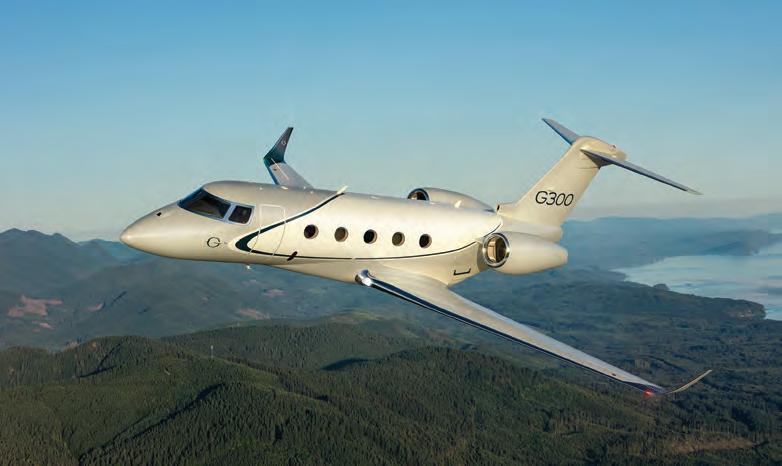
By Chad Trautvetter
Marking its sixth new aircraft model in 10 years, Gulfstream Aerospace launched the G300, a $28.9 million derivative of the super-midsize G280, two weeks ago during a customer event at its Savannah, Georgia headquarters. Notably, the long-rumored model has 10 Gulfstream-signature panoramic cabin windows, a 10-foot cabin stretch, and Honeywell Epic 2-based “Harmony” avionics.
During the event, Gulfstream president Mark Burns revealed a full-scale mockup of the G300 and showed photos of the first aircraft in production at IAI’s facility in Tel Aviv, where the company manufactures super-midsize jets under license for Gulfstream. Following the unveiling, the mockup was transported to Las Vegas, where it is being shown this week at Gulfstream’s NBAA-BACE static display alongside the G400 prototype and fully outfitted G700 and G800.
“Fueled by a decade of investment and our future-forward approach, the Gulfstream
next-generation fleet offers our customers the most innovative family of aircraft,” Burns said. “We know how important the super-midsize cabin segment is to our customers, so building on the highly successful G280 program, the G300 will reenergize the category with its heightened technology and safety enhancements, alongside the legendary comfort and styling of a Gulfstream.”
To date, nearly 22,000 hours of ground testing on the G300 have been conducted at Gulfstream’s lab facilities, including an integration test facility with iron bird capability. That facility also completed a virtual first flight last month. Meanwhile, nearly 2,000 ground test hours have been logged on the first aircraft, which is “being prepared for first flight,” a company spokeswoman told AIN. In addition, IAI has begun manufacturing two more test aircraft. Gulfstream has not provided an estimate for service entry, but industry sources point to first-half 2028 for start of deliveries.
Besides structural changes needed to accommodate the larger cabin windows and


fuselage stretch, the avionics switch from the G280’s Collins Pro Line Fusion to a Honeywell system likely denotes the biggest certification hurdle for the G300. The Harmony flight deck has six touchscreen displays, synthetic vision, and a predictive landing performance system. A pilot-side HUD is available as an option.
The G300 tips the scales at 39,750 pounds mtow, 150 pounds more than its predecessor, thanks to the two-foot cabin stretch and new windows. Payload is also about 200 pounds less, at 3,820 pounds. However, G300 performance is unchanged from the G280: 3,600-nm and 3,000-nm range at Mach 0.80 and Mach 0.84, respectively; 45,000-foot ceiling; and 4,800-foot cabin altitude at FL410. Its twozone cabin can seat up to 10 passengers.
Also unchanged between the two supermidsize-jet models are the aircraft’s two 7,624-pound-thrust Honeywell HTF7250G engines, conventional hydraulic control system with a yoke, 63-foot wingspan, and Mach 0.85 Mmo.
Business aviation analyst Rolland Vincent of Rolland Vincent Associates (RVA) called the G280 an “underappreciated airplane,” adding that the upgrades will give the G300 “the best cabin in its class.” He told AIN that the Harmony avionics suite helps to standardize the flight deck across the product line, not to mention simplifying the supply chain. RVA is now forecasting a boost in Gulfstream’s super-midsize jet deliveries, calling for 36 G300 handovers per year, up from 24 G280s. z
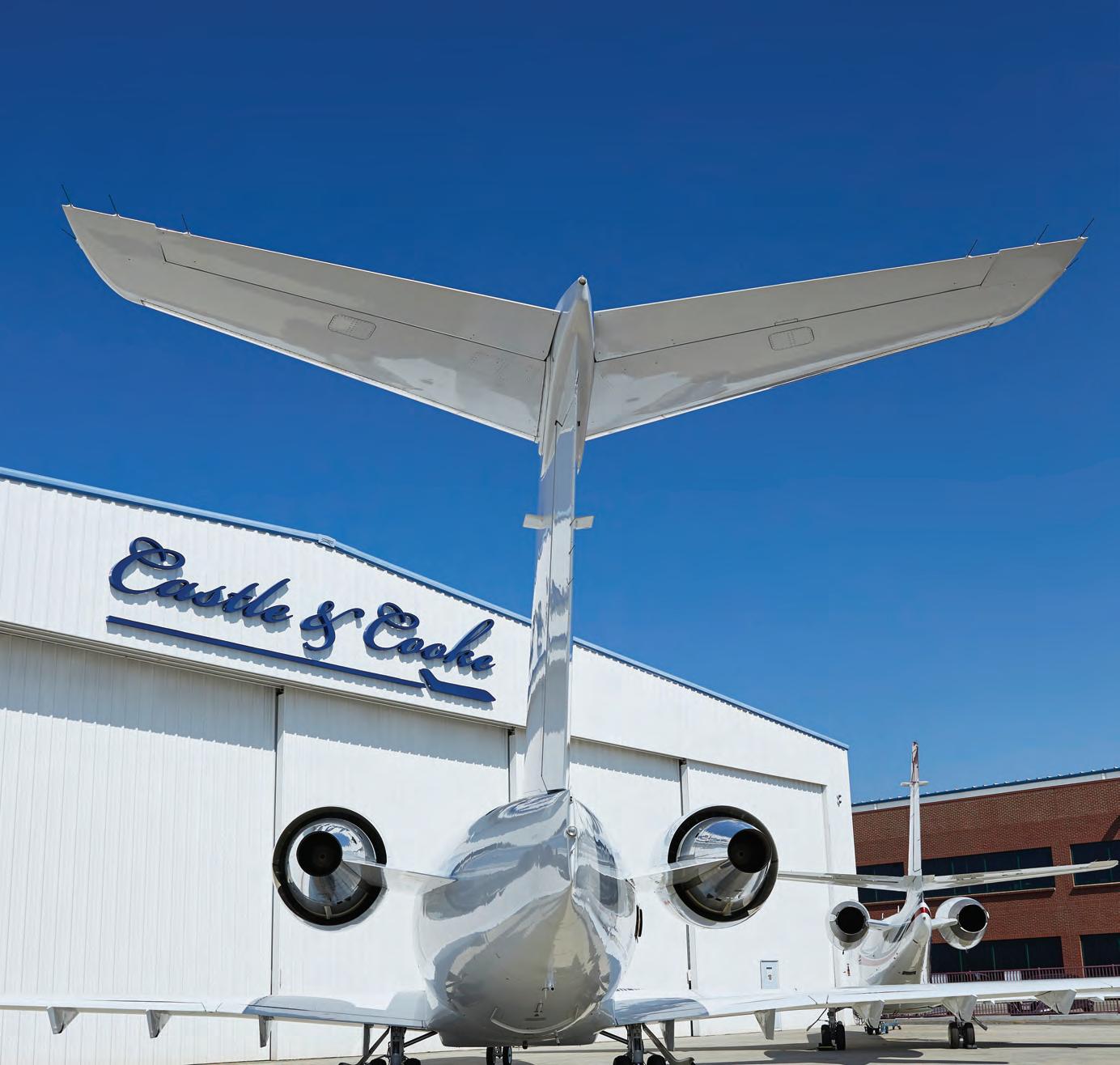


By Kerry Lynch
Hourly engine maintenance program provider Engine Assurance Program (EAP) continues to build on its portfolio with the additions of Rolls-Royce, GE Aerospace, Honeywell, and Pratt & Whitney Canada models to its product lineup. These include the RollsRoyce BR710C4-11, GE CF34-3B, Honeywell HTF7000, and P&WC PW308C that power aircraft such as Gulfstream G550, Bombardier Challenger 604 and Challenger 300, and Dassault Falcon 2000-series twinjets.
The additions, which have come online in recent months, expand EAP’s suite of hourly maintenance programs that target older model engines, joining venerable products such as the Honeywell TFE731, Rolls-Royce AE3007 and TAY 611-8, and P&WC PW500, along with auxiliary power units.
EAP was founded in 2016 to fill what it saw as a gap in the market: the support of older engines with lower-cost maintenance programs. Managing director Sean Lynch said EAP typically targets programs that have been in service for at least two decades.
“As they get to that about 20 years in service, that’s when we’ll add that model to our offering, so we’re just slowly increasing the models we’ll cover as they reach a certain maturity in the market,” Lynch told AIN EAP’s programs cover scheduled and unscheduled maintenance, as well as routine maintenance. In addition, its program offers engine health monitoring, oil analysis, and other services.

“With EAP, out-of-production aircraft can stay in the air longer, giving life to these still highly versatile airframes,” Lynch said. “The engines served by EAP have logged millions of hours of service. When EAP keeps an aircraft flying longer, there is an entire revenue stream/trickledown effect that feeds the whole industry.”
In a recent interview with AIN, Lynch discussed the importance of hourly maintenance programs, particularly for older models. “I believe that engine programs are the lifeblood of the business,” he said.
With EAP, out-ofproduction aircraft can stay in the air longer, giving life to these still highly versatile airframes.
— Sean Lynch, managing director
He pointed to an analysis he conducted of 10 Falcon 900Bs that had been parted out over the past decade. The common denominator: all but one were not on an engine program. In one case, the airplane was due for a C-check, a major periodic inspection of the engines, and needed Wi-Fi, paint, an interior, and landing gear overhaul. Ultimately, an MRO bought it for the parts.
“That airplane should have flown for 15 to 20 more years,” Lynch said. “If you look at the trickle-down effect of the revenue loss to the whole industry, it’s millions and millions of dollars—salaries, fuel, tires, wheels, brakes, paint jobs, brokerage fees, insurance, avionics.”
He estimated that, at a minimum, it represents about a $7 million revenue loss from the support side, and possibly millions more when you factor in operating costs over 20 years. “I just don’t think the industry understands how important it is for these things to be on a program,” he said. “The whole industry loses over a multi-year period.”
In addition to cost savings, EAP also said its program streamlines support for operators in that they may only need to work with a single vendor. “With EAP, you may only need one program for all your engine coverage needs, versus dealing with multiple different OEM programs. That saves customers time and effort,” Lynch said. “By not being affiliated with an OEM, we’re agnostic.”
As EAP has expanded its customer base, it has established a significant spare parts inventory and spare parts pool. Lynch said this became a necessity since the pandemic, given the supply-chain issues. EAP has developed its own supply chain. “We know that specific manufacturers don’t have fuel control units twice a year. We know that they run out of blades twice a year,” he said. “So, we just stock the parts. It’s not cheap, [but] we know we can’t rely on the system. So we made our own system.”
By taking proactive approaches, the company said its customers have a 99.98% dispatch reliability rate. z
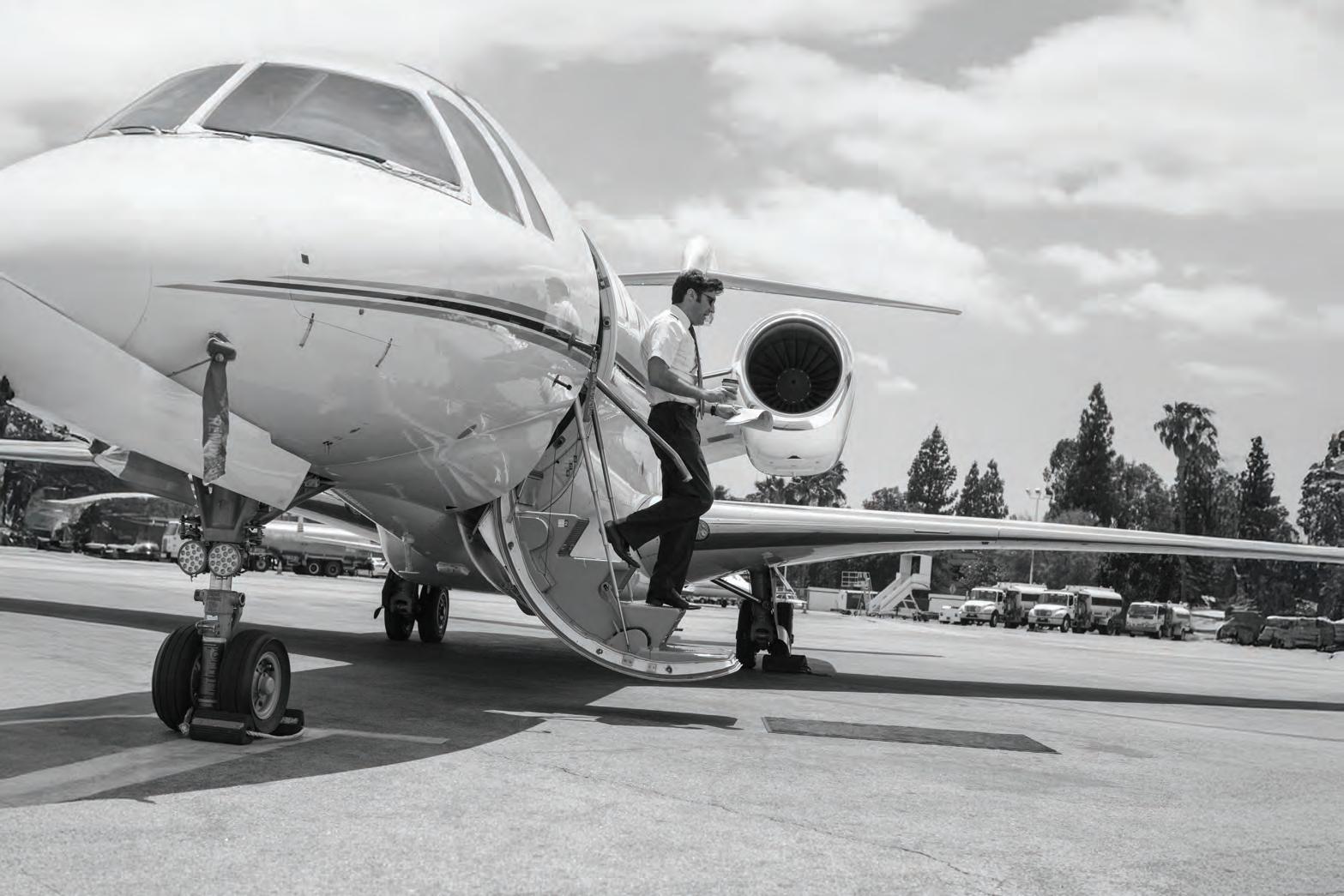
By Charles Alcock
The likely convergence between planned eVTOL air taxi services and mainstream business aviation has taken some shape over the past 12 months or so. Several FBO groups have begun work preparing to support the new aircraft, which could supplant helicopters in some instances, by developing vertiports and installing electric recharging equipment.
In August, Signature Aviation launched a partnership with Wisk Aero to prepare ground infrastructure to support commercial operations with the Boeing subsidiary’s autonomous eVTOLs. The companies agreed to develop vertiports alongside Signature’s terminals in Houston, Los Angeles, and Miami, which Wisk expects to be launch markets for its pilotless, four-seat aircraft.
Wisk is preparing to start flight-testing its Generation 6 prototype, having previously conducted more than 1,750 flights with five earlier iterations. The company has not yet established a basis for certifying the aircraft for autonomous operations with the FAA, and appears to be targeting service entry no sooner than 2030.
In June, Wisk announced airport partnerships in Miami and Kaga, Japan. The manufacturer’s agreement with Miami-Dade Aviation Department covers plans for vertiports at Miami International (KMIA), Miami Executive (KTMB), and Opa Locka Executive (KOPF) airports.
Last year, Wisk signed a similar agreement with Houston-area airports George Bush Intercontinental (KIAH), William P. Hobby (KHOU), and Ellington (KEFD), as well as with the nearby city of Sugar Land. The new partnership with Signature specifically covers plans for a vertiport at Ellington Airport, and the group has FBOs at all three Miamiarea airports.
“We anticipate that electric aircraft of all types, including eVTOLs, will be operated alongside our existing business aircraft operations,” a Signature spokesman told AIN. “The timing and nature of those operations is still to be determined and will vary based on the market and operators’ requirements.”
In June, Signature forged a joint venture with Italy-based advanced air mobility (AAM) infrastructure specialist UrbanV, which it indicated could lead to vertiports being developed at many of Signature’s 200-plus FBOs. The initial focus of the partnership is on airports in Florida, New York, California, and Texas, with the companies focusing first on the economic and technical feasibility of supporting the new mode of transportation. This will include installing electric charging equipment at New York City’s East 34th Street Heliport.
Atlantic Aviation also has ambitions to incorporate AAM support infrastructure with its business aircraft support network. In January, the group acquired vertiport developer
Ferrovial Vertiports, which has previously been working with eVTOL aircraft developers such as Lilium, Eve Air Mobility, and Vertical Aerospace.
“The goal is to build vertiports where the people are,” Kevin Cox, CEO of the Vertiports by Atlantic division, said at the NBAA regional forum in February. “We’re leading the way in vertiport development and now have four leases in Florida to build vertiports in city environments. AAM isn’t a matter of if, but when, and that when is within two years.”
Cox said vertiport sites can be as small as one acre or as large as two to three acres. “We’ll start with vertiports in big metro cities and then filter down to medium cities,” he added.
Atlantic is working with prominent U.S. eVTOL aircraft manufacturers Joby and Archer. Much of the focus is on providing infrastructure in the New York and Los Angeles areas, where early-use cases are expected to be established, and its plans could extend to more than 100 locations across North America.
Beta Technologies, which is developing the Alia 250 eVTOL and the CX300 conventional takeoff and landing model, has alliances with Atlantic, Signature, and Avflight covering the installation of its patented ChargeCube and MiniCube electric charging units at multiple sites. This technology is intended for use by multiple aircraft types, as well as by electric ground equipment.
Last year, the first Beta charger was installed at Atlantic’s facility at Elmira Regional Airport (KELM) in upstate New York, with plans also


covering the group’s FBOs at Alabama’s Birmingham-Shuttlesworth International Airport (KBHM), Jackson-Medgar Wiley Evers International Airport (KJAN) in Mississippi, and Westfield-Barnes Regional Airport (KBAF) in Massachusetts.
Signature has installed Beta chargers at FBOs along the U.S. East Coast, with the first site being Manchester-Boston Regional Airport (KMHT) in New Hampshire. Other installations have been made at Frederick Municipal Airport (KFDK) in Maryland and CharlottesvilleAlbemarle Airport (KCHO) in Virginia.
With state government funding, Avflight has installed the Beta chargers at four of its airport locations in Michigan: Lansing (KLAN) and West Michigan/Holland (KBIV) airports, Traverse City (KTVC), and Willow Run (KYIP). These installations tripled the number of FBOs where Avflight, which is part of the Avfuel group, has electric aviation infrastructure, with other FBOs located at Akron-Canton (KCAK) in Ohio and Columbus (KUBS) in Mississippi.
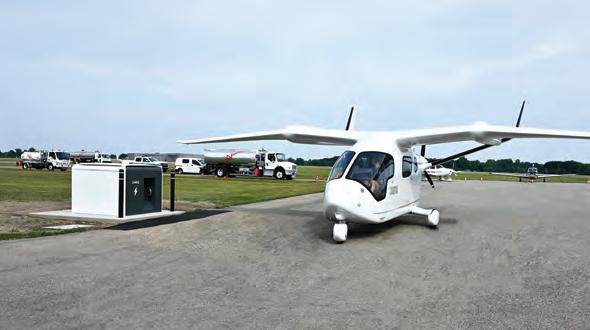
Clay Lacy Aviation has a partnership with eVTOL aircraft developer Joby, and also had an agreement with Overair, which in August effectively became part of rival Archer Aviation. One of the first locations earmarked for supporting eVTOL flights would be Clay Lacy’s FBO at John Wayne Airport in Southern California.
The small FBO chain is focusing on investments in electric charging infrastructure and determining how operational logistics can be
Archer Aviation has been designated the ocial air taxi provider for the 2028 Los Angeles Olympic and Paralympic Games and Team USA. This means athletes, VIPs, and some visitors will have the opportunity to fly on Archer Midnight eVTOLs to travel to and from key venues, including SoFi Stadium and the Los Angeles Memorial Coliseum. According to Archer, the aircraft could potentially also support security and emergency services during the event.
“Our vision is to fundamentally reimagine the Olympic and Paralympic Games experience, and this partnership represents an incredible opportunity to deliver something unprecedented, showcasing the very best of what Los Angeles has to o er on the world stage,” said LA28 chairperson and president Casey Wasserman.
Midnight is a piloted, fully electric aircraft designed to carry up to four passengers on trips of 20 to 50 miles. Archer plans to launch
Beta chargers have been installed at multiple airports and will be able to recharge a variety of electric aircraft types in addition to Beta’s CX300 conventional takeoff and landing airplane.
handled to support eVTOL air services. This will include installing Joby’s Global Electric Aviation Charging System, which the manufacturer said can be used by multiple aircraft types.
As part of its plans to launch air taxi flights in the New York City area, Joby has plans to use the existing heliport in Kearny, New Jersey. It has an agreement in place with the facility’s owner and operator, Helo Holdings. z
eVTOL air taxi networks across the U.S. and internationally, focusing initially on routes connecting airports with city centers.
San Jose, California-based Archer has been planning a Los Angeles-based eVTOL air taxi network since 2021, when it entered into a partnership with the city’s transportation department and Cleantech Incubator (née Urban Movement Labs).
Last August, Archer revealed its proposed locations for vertiports in the Greater Los Angeles area where Midnights will be able to take o , land, and recharge. In addition to SoFi Stadium and the Los Angeles Memorial Coliseum, Archer’s proposed Los Angeles eVTOL network includes vertiports at Los Angeles International Airport (KLAX), Hollywood Burbank, Orange County, and Santa Monica airports. H.W.

Archer’s planned eVTOL network in Los Angeles includes a vertiport at SoFi Stadium in Inglewood.

By Amy Wilder
NBAA is hoping that the FAA will work with industry to strike a balance on new privacy protections surrounding the aircraft registry to ensure those who need access to certain aircraft registration information can get it while still safeguarding operations.
The association is joining title companies, airports, aircraft transaction attorneys and others who are seeking a more flexible approach to changes in the aircraft registry that will shield information at the request of owners.
The changes were mandated by Section 803 of the FAA Reauthorization Act of 2024, enabling owners to submit privacy requests through the Civil Aviation Registry Electronic Services (CARES) system. Names, addresses, telephone numbers, and email addresses of registered owners can be withheld from public FAA websites at the owners’ request.
In addition, the FAA is considering whether to automatically withhold personally identifiable information from the public aircraft registry by default while providing owners with a means to access their data when necessary. The agency had asked for comments on the implementation of the law. That request closed in early June, drawing more than 300 submissions.
NBAA hailed the privacy changes and possible expansion of them. Increased privacy and security protections have long been a priority for the business and general aviation community, especially in the decades since individuals could track aircraft movements online.
However, at the same time, it acknowledges that this raises issues for those who use the information for transactional and other purposes. Doug Carr—NBAA’s senior v-p of safety, security, sustainability, and international operations—acknowledged the concerns that there are several legitimate reasons for people who need to access the registration information. “For a host of other legitimate reasons, there is value in providing access

to that information,” he said. But as the FAA explores that access, Carr continued, to start with, “there are basically two statuses—You’re in the program or you’re not. While it sounds good, that may not be the best approach.”
Title companies fear that privacy limitations could lead to aircraft titling and sales problems. “Making sure that people cannot track flights is not a bad goal. There are security reasons, there are safety, maybe even confidentiality reasons for businesses,” AIC Title Service general counsel Bruce Marshall wrote in one of the comments. “But the problem is…the FAA was co-mingling operational information, ADS-B information, and ownership information. The registry originated so that you could follow the legal documents and have some way of determining ownership and interests in aircraft.”
Aircraft financiers and attorneys worry the changes would upend due diligence and open the door to fraud. “It would be like buying a house and not checking the title,” said Clay Healey of AIC Title. “We can’t do our jobs for people.”
The FAA aircraft registry is an owner-based system, meaning it often lists the legal titleholder, not necessarily the aircraft operator. In many cases, the operator is a lessee, trust beneficiary, or related company. As McCreary noted, restrictions on LLC disclosures could also unintentionally expose beneficial owners even when privacy structures are in place.
Newly enacted privacy changes to the FAA aircraft registry could have a negative effect on vital services such as aircraft titling during the sales process.
In light of these concerns, stakeholders are urging the FAA to adopt a tiered-access approach that protects individual owners while maintaining verified access for those with operational, legal, or regulatory responsibilities. NBAA stressed that both goals can be achieved. Carr noted that state driver’s registries already have tiered access in place for authorized users. “It’s that approach that we think would facilitate a reasonable balance between requests for privacy protection and the security that comes with that.”
The efforts to shield registration information come as technology increasingly has made privacy—and security—more difficult “As soon as the technology was available to track, people wanted to do it,” Carr said. “This began back in the mid- to late 1990s, when the internet was still nascent and ascendant.”
NBAA has gathered impact stories from business leaders who found their competition had been a step ahead by tracking their aircraft patterns to individuals being followed by their “biggest fans.” The cases have been numerous, including sports figures’ trades discovered by reporters tracking them, and activists targeting celebrities through aircraft movements.
Carr concedes that the registration changes are not a complete answer. “There is no silver bullet to this. What it will do is make it harder to identify a blip in the air and who it is, because today, that information is easily referenced with the aircraft registry database at the FAA.” z
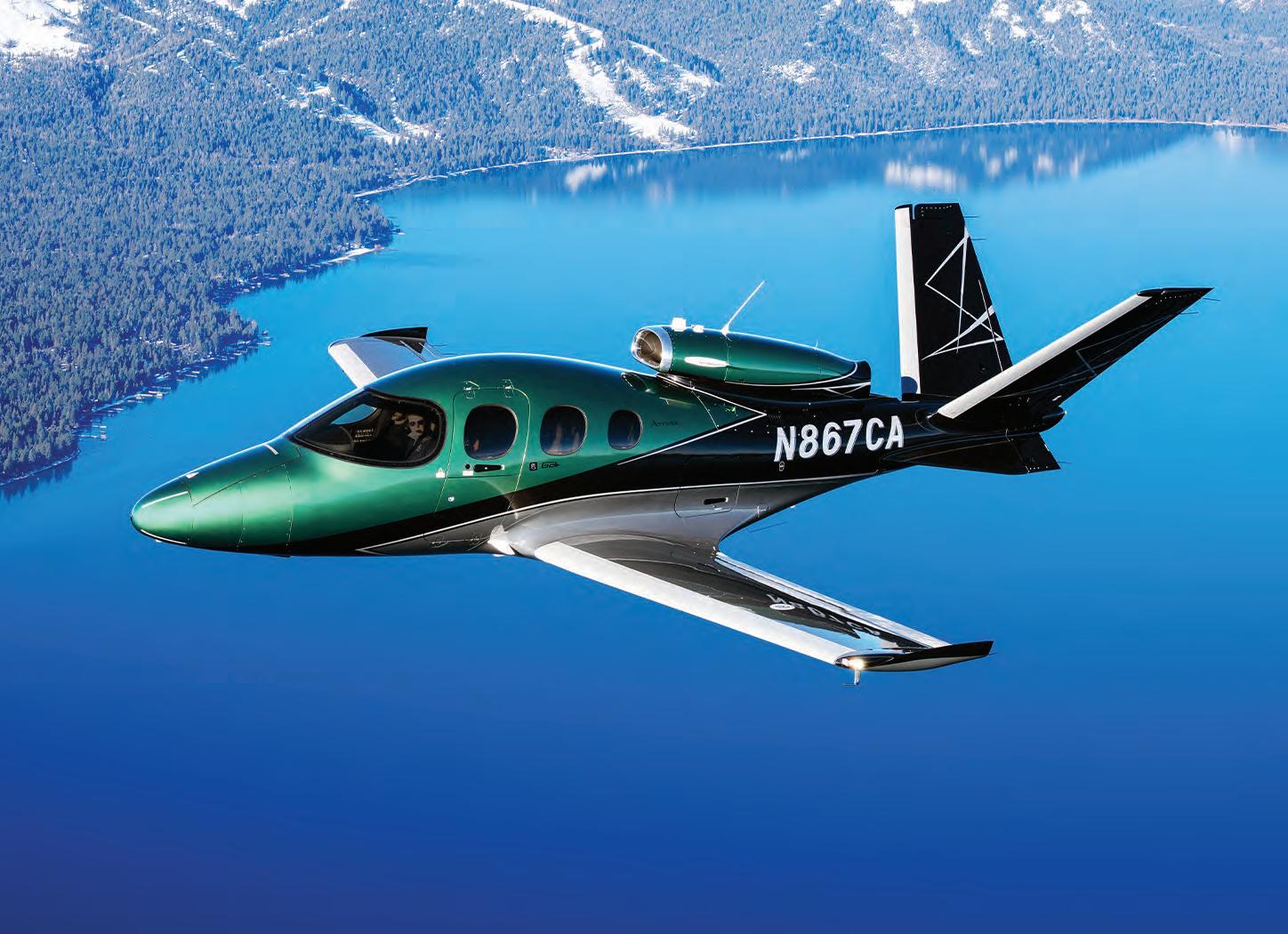
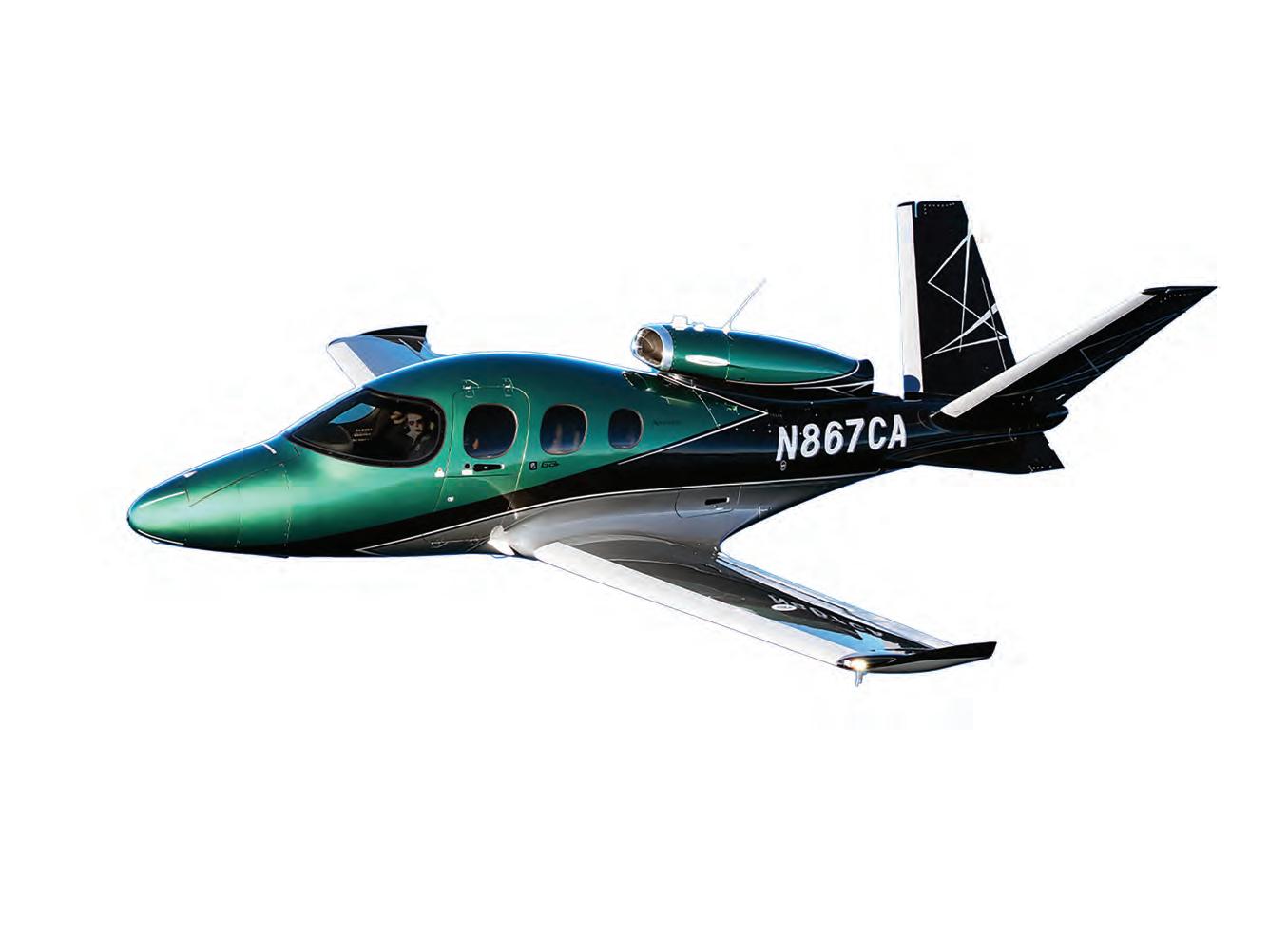
Owning a Vision Jet is effortless with Cirrus. From acquisition to management, and with programs such as Cirrus One and JetStream, enjoy streamlined ownership and dedicated support that is designed to enable every mission.

By Matt Thurber
Aircraft type clubs and owner associations have always offered significant benefits for members, especially for aircraft that are no longer manufactured. But now these groups are stepping up with compelling new reasons to join.
One of the most interesting recent developments is the launch of new insurance underwriters dedicated to the needs of owner-pilots teaming up with these associations. Class A Insurance and 5X5 Aviation Insurance—partnering with the Citation Jet Pilots (CJP) and Piper M-Class Owners & Pilots (PMOPA) associations, respectively—recently began offering coverage for high-performance airplanes.
Both direct-to-consumer underwriters provide special discounts for owner association members, and neither focuses on pilot age as a factor to deny coverage, relying on flight data to support the underwriting process.
Another sign of the resurgence of owner clubs was the September MU-2 Pilot’s Review of Proficiency (PROP) seminar hosted by Mitsubishi Heavy Industries America (MHIA) in Plano, Texas. The PROP seminars used to be held nearly every two years before taking a long break, and now the company is planning to continue serving MU-2 owners
and prospective buyers with ongoing safety events. For MU-2 owners, there is also an owners’ association called MU-2 Flyers, and it holds safety seminars called MAX RPMs.
Almost every aircraft type has an owner association—for example, the newly formed Kodiak Owners and Pilots Society, created to serve the owners of the more than 350 Kodiak single-engine turboprops that have been delivered. CJP has long been the go-to for safety information about Cessna Citations, and its members have an enviable safety record, thanks to CJP’s ongoing efforts to improve their flying skills.
Pilatus PC-12 owners have the Pilatus Owners and Pilots Association, and TBM flyers have the TBM Owners and Pilots Association. These groups aren’t just for smaller aircraft; a few years ago, a group of owners formed the Independent Falcon Aircraft Operators Association.
Meanwhile, PMOPA held its annual convention in Lake Geneva, Wisconsin, last month, with 260 attendees and 70 airplanes flown to Kenosha Regional Airport.
“This year’s PMOPA convention demonstrated the association’s ongoing commitment to excellence in education, safety, and member engagement,” said PMOPA CEO Mike Nichols. “From robust, safety-focused programming
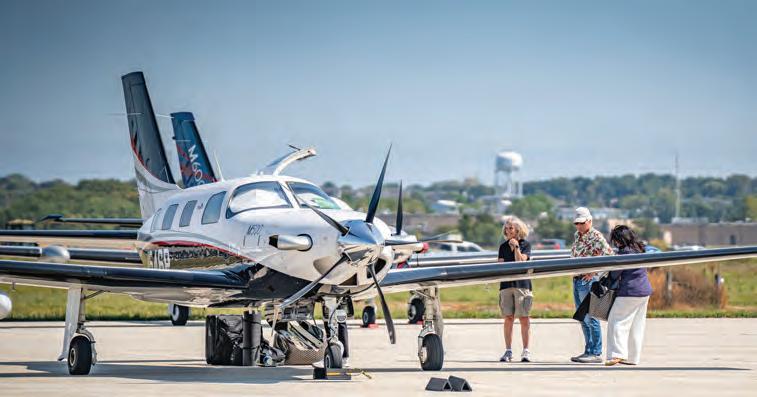
and a dynamic exhibit hall to exceptional networking opportunities, the event reflected the strength of our community and the value PMOPA delivers to its members.”
Aircraft associations are not only gatherings of like-minded aircraft owners and operators, but many also offer advanced training programs that go well beyond minimum FAA requirements. Participation in these training programs can help o ffset insurance costs, especially when coupled with flight data monitoring systems that record and analyze pilot performance and the new direct-to-consumer insurance underwriters.
Evidence that owner-group safety programs work comes not only from CJP but also from the TBM Proficient Pilot Program (TBM-PPP), which launched at the 2024 Avex Aviation Safety Seminar. In its first year, TBM-PPP’s 50 members with a collective total of 70,000 accident-free hours helped move the group towards its goal of 100 members, three years, and zero accidents.
Flight data is recorded using Daher’s Me & My TBM platform, and “TBM-PPP monitors every flight, flags performance drift early, and builds accountability through a member-run safety management system and peer ‘safety buddy’ reviews—without punitive measures,” according to the group.
The annual Piper M-Class Owners & Pilots
Association held its annual convention in Lake Geneva, Wisconsin, and owners of 70 Pipers flew their airplanes to Kenosha Regional Airport to attend the event.
At the recent MU-2 PROP seminar, owners of many of the more than 200 still-flying MU-2s flew to Addison Airport in Texas for two days of sharing information and MU-2 learning sessions. Also attending were pilots interested in buying MU-2s who wanted to learn more before making a purchase decision.
During the firstday presentation by Ron Renz, a long-time MU-2 pilot and owner, flighttest pilot, engineer, and mechanic, he focused on knowing your airplane. “When was the last time you really looked at your AFM or POM?” he asked, pointing out that because MU-2s are getting older, each one is unique, with multiple modifications that pilots need to understand.
“There are no MU-2s the same,” he said. “Not a single MU-2 has the factory configuration anymore. Have you studied your installation? Look at the AFM, the limitations, and... the gotchas; every one has them.” z

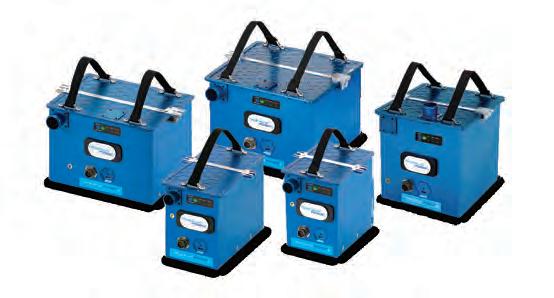
By Charles Alcock
Rolls-Royce aims to be supporting more than 1,600 CorporateCare Enhanced contracts for operators of business jets powered by its turbofans by year-end. The manufacturer continues to expand its product support network as deliveries ramp up on engines developed for new models such as the Gulfstream G700 and G800.
In response to input from operators, Rolls-Royce is implementing changes to CorporateCare Enhanced’s terms and conditions. For example, following a meeting in September of the company’s U.S. Corporate Customer Council, it is adding coverage for foreign object damage to Pearl 700 fan blisks, which has previously been solely covered by insurance.
“Having already covered parts and labor [for repairs], we’re now focusing more on the customer experience, with the aim of making our support more seamless for operators,” explained Lindsey Gillen, v-p of sales and marketing at Rolls-Royce Business Aviation Services.
This week at NBAA-BACE, RollsRoyce’s new exhibit is providing visitors with an interactive experience to learn more about every aspect of CorporateCare Enhanced. It is also promoting its new Priority Access, Premier Support brand, and pledge that any money spent on the support packages will always be recouped through its positive contribution to aircraft resale values.
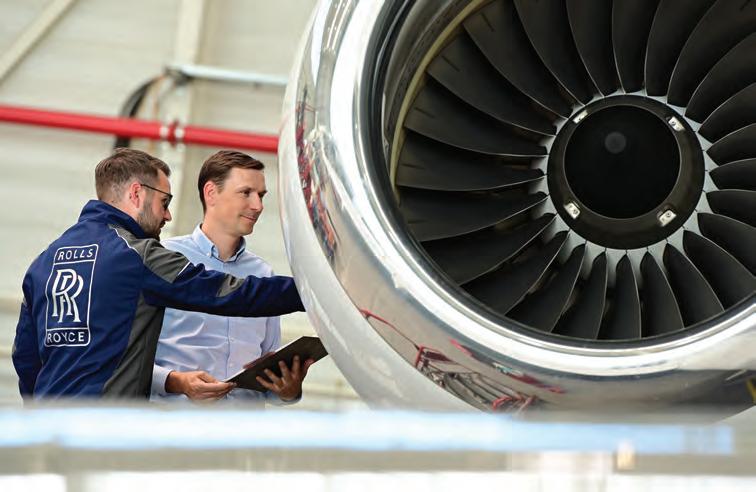
Rolls-Royce is using artificial intelligence tools to assess and respond to health monitoring data.
CorporateCare flight-per-hour rates are subject to pre-determined escalation rates, which Rolls-Royce says are now more stable and predictable. Part of this stability comes from the company’s increased use of artificial intelligence to assess and proactively respond to data generated by its engine health monitoring systems.
For the latest Pearl engines, Rolls-Royce’s engineering team in Dahlewitz, Germany, can now check around 10,000 performance parameters at a rate of about one data point per second. In addition to hot section engine parts, the technology can also track elements such as hydraulic systems, where signs of slower performance might be an early signal of problems that can be prevented.
The first Pearl 800 turbofans for the Gulfstream G800 were delivered in August. Gillen told AIN that the company is now preparing to start supporting operators of the Dassault Falcon 10X from 2027, when the twinjet is expected to enter service.
For the AE3007 and Tay engines, CorporateCare Enhanced includes troubleshooting and mobile repair team travel costs. For the Pearl 15, Pearl 700, BR710, and BR725 models, the cover extends to maintenance for the whole powerplant, including the nacelle, engine build-up, and thrust reversers, as well as related services such as dealing with corrosion and erosion.
Rolls-Royce engines power more than 4,000 business aircraft, and the company claims almost a 70% share of the propulsion market for very-long- and ultra-long-range, large-cabin jets. More than 2,500 business jets are covered by the CorporateCare Enhanced and standard CorporateCare programs, and 75% of newly delivered Rolls-Royce-powered aircraft are now covered by the former.
CorporateCare Enhanced hourly rate contracts run for 10 years, and if the aircraft is sold before the end of that period they can switch to a new contract. According to Rolls-Royce, operators covered by the contracts receive 35% more value in terms of the maintenance costs they would incur if they were not covered and paid the expenses out of pocket.
Rolls-Royce has invested around $1 billion in its service center network for business aircraft engines. This commitment includes 10 parts stores worldwide exclusively for CorporateCare operators to ensure that they have priority access at a time when supply chain issues can cause maintenance delays.
The manufacturer has 85 service centers worldwide, in addition to 85 on-wing service technicians who can be dispatched to assist operators. It also holds around 250 lease assets, including engines and nacelles, that can be fitted to customer aircraft during maintenance work. z
Working with Global Jet Capital means getting more:
• More experience, with aviation industry experts who’ve completed thousands of aircraft transactions across jurisdictions
• More possibilities, with deep domain knowledge enabling us to make complex deals happen that otherwise would not
• More options, with financing solutions tailored to your unique needs, whether you’re acquiring a first aircraft, expanding your fleet, or considering an upgrade.
Learn what’s possible with Global Jet Capital. 844.436.8200 \ info@globaljetcapital.com globaljetcapital.com
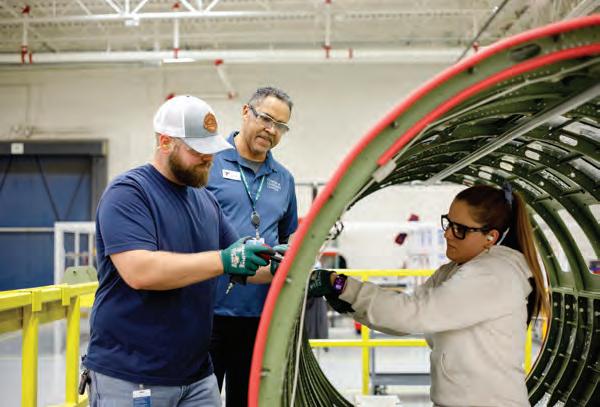

By Kerry Lynch
Textron Aviation is seeing early successes through several workforce training initiatives—from its new career center to veterans’ programs—as it continues hiring at a rate of about 100 employees a month, company executives told AIN
The cornerstone of its workforce training initiative is the new $40 million Career & Learning Center that had a soft opening last year and a formal dedication six months ago with dignitaries such as Kansas Gov. Laura Kelly and Sen. Jerry Moran (R-Kansas). That facility, on the east side of Wichita at its campus where the Beechcraft product line is produced, was transformed from a parts warehouse into a multipurpose recruitment, pre-employment, and training center.
“This is a big deal to us,” said Textron Aviation president and CEO Ron Draper. “It’s a 100,000-sq-ft facility dedicated to recruiting new employees, hiring, putting them through all the pre-employment checks, and then on the day they start, they go through orientation there.”
The center encompasses a classroom setting and a simulated factory. “They’re not
just learning in a classroom; they’re going out and working on a fuselage, a wing, or whatever their job classification is, and even if they have no skill, they’re probably getting eight to 10 weeks of training and building confidence before they report to their first job,” he said.
Hundreds have already gone through the center, and Draper said the difference is notable. Before, a new hire may get two to three weeks of training, and then they are sent for on-the-job training where they are paired with a senior employee and a supervisor, with instructors who may float among the various factories.
“In some cases, you know, they were overwhelmed. It was too much too fast, and we had a high turnover,” he said. “In this process, that turnover is reduced substantially, I think 20% to 25% reduction in the turnover of those new employees because they’re getting longer to go through training, they’re getting longer to build confidence, they’re getting longer to just feel the culture and grow some a ff ection for the company. So, when they arrive at their job, their supervisor says they’re much better prepared. It’s been a success.”
As far as the training, the instructors are longtime employees with substantial experience behind them, Draper explained. “They’ve taken ownership of the process to say it’s my job to ensure that these folks are well trained. So, we’re excited about that.”
But Textron Aviation is continuing to refine the process. “We’re just looking at how do we improve it,” he said. About 80% to 90% of its job classifications now go through the process. Textron Aviation hopes to have 100%, whether in maintenance, production, or the executive suite, process through the center.
The Career & Learning Center is divided into four different zones to support applicants and employees in their hiring and training journeys.
Unique about the center is that it is open to the public. Any person interested in a job can walk in during its public operating hours (7:30 a.m. to 4:30 p.m. weekdays with extended hours until 6 p.m.), said Jennifer Whitfield, director of human resources, talent development, and professional training. Potential applicants would walk into the first of four zones at the center: the Career Zone. There, they could apply for a job, obtain help with a resume, or maybe even have an interview at the time, Whitfield said.
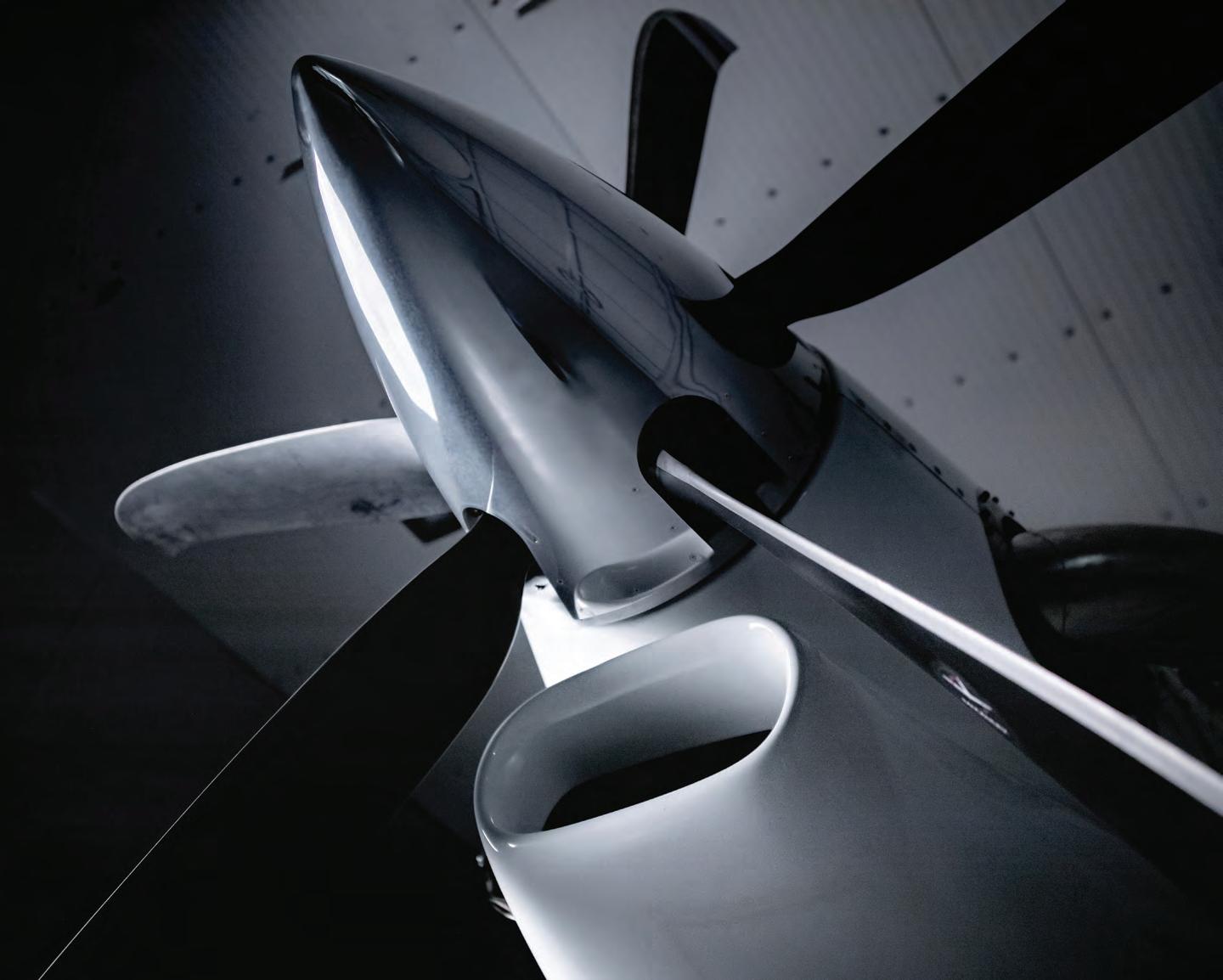
The Catalyst engine is the first new centerline, clean-sheet advanced turboprop of the 21st century to be certified to the latest standards. Designed and manufactured entirely at GE Aerospace sites in Europe, it incorporates industry leading technologies and features that make it the ideal architecture to develop more sustainable propulsion systems.
Next is the Pre-Employment Zone, which involves onboarding activities such as any necessary pre-employment testing and orientation for new hires. A third area is what Textron Aviation calls a Learning Zone. This encompasses professional and technical training rooms to provide classroom and hands-on learning. The west bay hangar was turned into a simulated manufacturing floor, enabling training on aircraft production and other skills.
The final “Design. Build. Fly.” zone is public-facing—a space dedicated to bringing in students from kindergarten up through 12th grade with age-appropriate activities to introduce them to aviation and science, technology, engineering, and mathematics.
Among the activities is a Cessna Skyhawk 172 simulator that students can experience flying.
The center is among the many initiatives that Textron Aviation has ongoing in the area of workforce development and community outreach. Partnering with local schools, the company is involved in multiple areas with Wichita State University.
But one of its efforts that is a focal point is its veterans’ outreach programs. This is such an important program for the company that it is sponsoring NBAA’s inaugural Military Connect program tomorrow at NBAA-BACE. Military Connect is a full-day event to provide resources, educational sessions, and networking opportunities for military personnel transitioning into civilian life. Textron Aviation will have one of its military recruiters on hand for the event.
Textron Aviation uses multiple avenues for recruitment, such as SkillBridge and Heroes Make America programs that introduce military personnel to civilian manufacturing and other jobs. These are in addition to its other recruitment activities.
Senior manager of HR for military programs John Buckley—a 30-year U.S. Army veteran who was involved in planning efforts in Bosnia, Iraq, and Libya—spearheads recruiting, marketing, and retention efforts at Textron Aviation.
The company believes it is critical to hire veterans for three major reasons: a need
(the company faces a workforce shortage along with industry); a requirement (it needs to have a percentage of military personnel for its government contracts—a figure it more than surpasses); and the value that they bring the company: skills, experience, and high operational tempo, Buckley stressed.
“Their culture, the character, is perfectly aligned with our values, and we see that as a strength,” he said.
However, recognizing that a transition from military to civilian life is not so simple, Textron Aviation has set in motion a range of activities to ensure that the company is “military ready” rather than just “military friendly,” Buckley said.
“In simple terms, being military friendly is that you hire military veterans, but ready goes beyond that. Ready means that you’re doing some extra things—you’re taking into account, for example, that the transition of military service into the private sector in general and into civilian employment is very complicated, very challenging.” z
Aircraft registered in Europe will no longer be able to carry Halon 1211 fire extinguishers after December 31, except for certain cargo comparment and fuel inerting applications that use Halon 1301. This rule does not apply to U.S.-registered aircraft flying in Europe, according to NBAA, but operators may want to consider that their Halon extinguishers will not be serviceable in Europe after the deadline, warned H3R Aviation senior v-p Chris Dieter.
In the U.S., Halon can still be used and is still available, although its manufacture has been prohibited since 1994. Enough Halon was made and is being recycled to keep extinguishers filled for probably the next 10 to 15 years, Dieter said, but it will eventually be exhausted. To help European operators and others that want to switch to a non-Halon fire extinguishing substance, H3R Aviation has released a line of Halotron BRx extinguishers, which it is
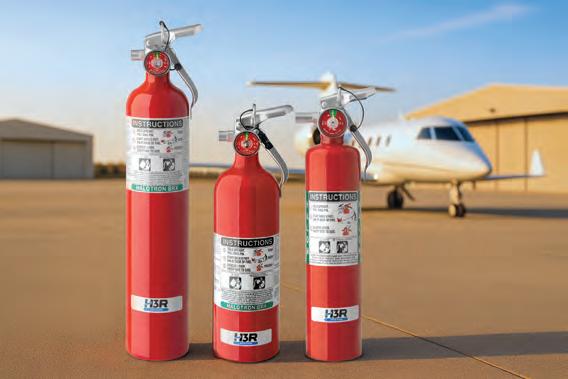
Halotron BRx is a suitable replacement but costs four to five times as much.
highlighting this week at NBAA-BACE. H3R is also o ering a 10% discount at the show and holding a giveaway of a Halon extinguisher at its booth.
“The problem with BRx is it’s very pricey,” Dieter said, “four to five times as much as Halon. For a typical 347TS portable steel cylinder, the Halon type weighs 5 pounds. By making an aluminum cylinder, H3R Aviation was able to keep the size and weight of the Halotron product almost the same, at 5.1 pounds. Most of H3R’s Halotron cylinders are drop-in replacements with the same dimensions as the Halon type, so there is no problem fitting the replacement.
“We found that a lot of companies who contact us hadn’t realized that Halon is still available,” he said. Some customers from Europe are just learning about the rule, and in these cases Dieter tries to educate them not to buy a Halon extinguisher. “It’s not a good idea as they will have to replace it by the end of the year. We’re trying to get the word out.”
M.T.

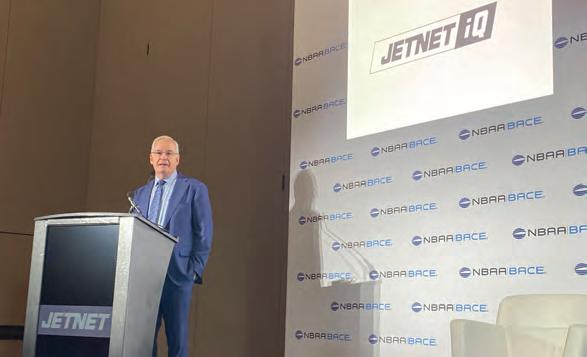
Presenting results of the company’s Q3 business aviation survey, JetNet iQ founder Rolland Vincent said the business aviation market remains strong, despite tariff headwinds.
By Curt Epstein
Volatility is the best word to describe the current state of the business aviation market, according to Rolland Vincent, president of Rolland Vincent Associates and creator of the JetNet iQ Survey. Speaking at NBAA-BACE on Monday, Vincent explained that while factors such as geopolitical risk and tariffs are driving some discomfort and uncertainty among aircraft buyers, the demand signals are still very strong.
For this year, JetNet forecasts deliveries of approximately 820 business jets, up 8% from last year’s total. If that prognostication bears out, that would make 2025 the first year since pre-pandemic 2019 where deliveries surpassed the 800 plateau, and only the second time since 2009 at the start of the Great Recession.
Despite the trend of rising deliveries, backlogs among the “Big Five” OEMs—Bombardier, Dassault, Embraer, Gulfstream, and Textron Aviation—continue to rise. “We’re seeing very persistent backlogs of over two years of production, which is a really nice place to be,” said Vincent, “but frankly, from an OEM point of view, you want to start turning that backlog into more cash. We could probably easily be doing 1,000 airplanes this year as an industry, and even for a sustained period.”
To further illustrate that demand, Vincent examined the on-market inventory of many
popular preowned aircraft models and found most with but a handful available. “We’re in a strong demand market, tight supply,” he noted. “If you’ve got one of these for sale, you are in a very strong pricing position.”
According to Vincent, issues that have restrained the industry over the past several years still persist. “We continue to have, after all these years, supply-chain, supplier, talent experience, and talent pipeline issues,” he stated. “So we have a really nice backlog, well-priced deals of course, if you are the seller, but we’re still not getting over the supply challenge.”
JetNet iQ has been conducting its operator surveys for nearly 15 years, and in every quarter, it asks its respondents “how they would describe the current market conditions for business aviation.” In its just-completed third-quarter survey, nearly 55% indicated that we are past the current low point, while slightly over 30% felt that the market has not yet reached the low point.
That equated to the highest optimism score in the survey since third-quarter 2022, and the largest jump from one quarter to another in survey history. In the second quarter of this year, the survey indicated strong pessimism, driven by the imposition of U.S. tariffs and their contribution to market uncertainty.
The survey found that the restoration of 100% bonus depreciation would at least somewhat
positively influence the purchase of a new aircraft in the next year among more than 59% of respondents. However, the uncertainty rising from the tariffs would at least somewhat negatively impact plans for aircraft purchase over the next year for nearly half the respondents.
While the survey focuses on feedback from business aircraft operators, it should be no surprise that they would agree with the statement: “Without business aviation, my/ our company or organization would be less successful and less profitable.” Nearly 87% of respondents indicated they would endorse that statement at least somewhat.
Among the new aircraft models attracting the most attention from the respondents in this recently closed survey, Gulfstream and Pilatus each occupied two of the top slots, the former with its G400 and G800, while the latter was represented by its PC-12 turboprop single and PC-24 light jet.
The PC-12 was the top model among preowned aircraft as well, tying with the Gulfstream G650/G650ER and Cessna Citation Excel/XLS/XLS+.
Respondents said supply-chain recovery and aircraft MRO capacity are the top industry challenges over the next five years.
The 4.5 million global business jet and turboprop flights through September of this year represent a 3.7% increase over last year, with North America accounting for 67% of that activity, according to Christoph Kohler, founder and managing director of JetNet subsidiary WingX.
In the U.S., WingX examined the U.S. cities with the fastest-growing millionaire populations and found that they closely aligned with areas showing the largest increases in private jet activity. The Southeast experienced a rise of more than 46% since 2019, followed by the Southwest at 33%.
Corporate flight department activity has declined, but according to WingX, it has not been eliminated; it has merely migrated to the fractional segment.
In Europe, it noted that many factors have combined to mute growth, including the war in Ukraine, economic stagnation, political instability, and environmental activism.





Preowned and new aircraft transactions are expected to increase steadily over the next five years.
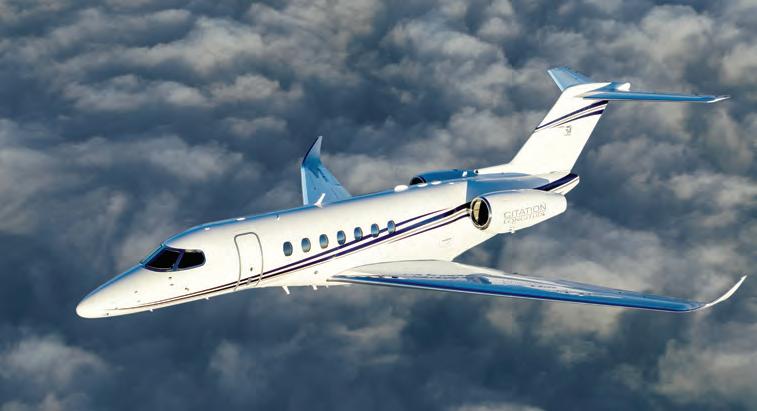
By Kerry Lynch
Global Jet Capital, releasing its business jet forecast, sees steady continued growth in the next five years with transactions nearing $40 billion in 2025. Further, GJC anticipates this growth to continue fairly steadily over the next five years, averaging about 4.2% for preowned and 2.7% annually for new-production jets.
“We’re seeing a very good and balanced market,” GJC CEO Vivek Kaushal told AIN “Clearly, we turned the page coming out of Covid, and the story has just continued to build in this really nice and steady fashion.”
In all, GJC forecasts that total market volume will reach 3,383 in 2025 and 3,778 by 2029. This compares with a unit volume of 3,125 in 2024. The high level over the decade occurred with the post-Covid bump in 2021, when used aircraft transactions surged, pushing the overall transaction volume to 3,963.
Preowned transactions will account for 2,604 aircraft this year, growing to 2,926 in 2029, GJC forecasts. New-production deliveries, meanwhile, are anticipated to reach 779 this year, up from 746 in 2024, growing to 852 in 2029.
As for dollar volume, the market is anticipated to total $38.7 billion this year, over half of which—$20.1 billion—will involve new
deliveries. This reflects the balance weighing toward larger jets for new versus used. Likewise, in 2029, the total transaction volume is anticipated to reach $44.2 billion, with new deliveries accounting for $23.5 billion of that.
“If you look at new deliveries of aircraft, we bottomed out at $14.2 billion in 2020, and that went up gradually to $19 billion by 2024. This year, we think we’re going to be at about $20 billion, and so if you look at that trough to peak ratio of about 50% or a little under 50%, that’s actually a Goldilocks kind of ratio from our perspective,” Kaushal said.
He pointed to the Covid-constrained production environment and noted the industry’s ability to bounce back at the rate it has. “I think that speaks volumes of the maturation of the industry,” he said.
A key driver of this, on the new delivery side, is backlogs that are 62.2% greater than in 2019, topping $50 billion, with most models sold out by more than two years. “All of that just goes to tell us that there’s stability in this dynamic,” he said.
Kaushal also believes this will be sustained, doubting that the industry would undergo a similar bubble burst as in the 2008 and 2009 timeframe. He pointed to the market before the Great Recession of 2008 and 2009, saying
it was much more “frothy.” During that time, production rates doubled from 2003 to 2008, and book-to-bill rates of 2:1 to 2.5:1.
Today, those ratios are much more level at nearly 1:1. “You’ve got an industry that’s just in this really nice stable dynamic; they’re coming up with new models, which is exciting, and you’ve got a demand base that’s very grounded,” Kaushal maintained.
That maturity is now playing out in the preowned market. Young aircraft, those less than five years old, and anything “high quality” have no trouble selling, he said. But it is occurring in an organized, stable way: “We’re not seeing like bidding wars, and at the same time we’re seeing very prompt cycle times.”
When GJC gets a five-year-old aircraft at the end of the lease, “it’s usually gone 60 days into our marketing process. We’re seeing just a really strong market.”
He noted that the market should push past $40 billion in 2026 or 2027 in total transactional sales. New deliveries should top 800 aircraft next year, Kaushal noted, with growth across all segments of the business aviation market and particularly for charter.
In the early 2000s, aircraft purchase agreements were assignable, creating an active market in trading delivery positions. “You had people placing speculative orders just because they felt they could trade those orders for a profit. That’s no longer the case.”
Kaushal maintained that this was a key driver of the slew of order cancellations. Today, the cancellations are more one-off. “You wouldn’t see anything on the scale of what happened back then.”
In addition, the supply chain is metering how fast companies can ramp up. “I think the supply chain is going to be a meaningful constraint. There are, of course, supply-chain issues, but they’re not as widespread as they were three years ago.”
As for current market trends, GJC has seen a shift in customers realizing they need to long-term plan for an acquisition. “You can’t expect to walk up and walk out with a brandnew aircraft,” he said. “Even for a preowned, if somebody really wants an aircraft of a certain pedigree—certain vintage, performance, and interior—it just takes time, and it takes clarity of what you want.” z

By Matt Thurber
Apcela, the network systems developer that built and operated the air-to-ground airborne connectivity system created by SmartSky Networks, has relaunched the service and rebranded it as Apcela ATG. The move follows Apcela’s purchase of the ATG network from SmartSky earlier this year and enabled operators that installed SmartSky systems to switch their systems on again after the network abruptly shut down in August 2024.
After years of delays, SmartSky launched the ATG service at the end of 2021 and into early 2022, eventually operating more than 300 ground stations in the U.S., providing full coverage in the continental U.S. and up to about 100 miles offshore.
Last October, Apcela announced an agreement to acquire the SmartSky network. “It was essentially an acquisition and restructuring agreement,” said Apcela CEO Mark Casey, “to benefit all the former SmartSky creditors, and that is structured with SmartSky principal debtholder BlackRock. We worked with SmartSky and BlackRock to come up with a solution that could benefit all.”
During the shutdown, Apcela kept the dozens of former customers who had original systems installed informed. They were excited, he said, and eventually became beta testers for the revamped ATG network, which relaunched not all at once but from east to west as ground stations came back online over the summer.
The rebranded ATG systems that Apcela is offering include the Apcela One and Dual ATG systems. The One is a single-antenna system designed for smaller aircraft, and Dual provides higher performance with two

antennas. Both systems are on display at Apcela’s NBAA-BACE exhibit, and Apcela is o ff ering “Sign and Fly” incentives for new installations, similar to the way consumers buy smartphones or cars. These include dealer incentives and rebates on the hardware, according to Casey, and low-interestrate financing.
“Essentially, we are making it very low cost out of pocket to reduce friction for ATG upgrades,” he said.
Apcela ATG has relaunched its dealer network, and three preferred dealers are coexhibiting at its NBAA-BACE booth: Altus Aerospace, Brunswick Aviation Services, and Davinci Jet Services. “Our clients demand the
same speed and reliability in the air that they enjoy on the ground,” said Davinci Jets CEO Eric Legvold. “Apcela’s next-generation ATG technology delivers exactly that—streaming, communications, and real-time data without interruption and at a tremendous value.”
Skyward Aviation has selected Apcela ATG and will install the One ATG system in its fleet of 11 Learjets by early 2026. The installations will be done by Brunswick Aviation at Skyward’s Washington, Pennsylvania maintenance facility using Apcela’s Hybrid Installation Program. This streamlines installations by combining the expertise of the dealer and local maintenance resources and by scheduling the installation during regular maintenance events. z
Lone Mountain Travel, which supports members of Big Sky-area resorts and ranches in the Western U.S., has adopted Moove’s AI-powered aircraft booking and jet pooling tool. Moove allows users such as Lone Mountain Travel to create whitelabel portals for booking trips on behalf of customers.
More than 200,000 passengers travel via Moove’s platform every year, with trips arranged by 30 Part 91 flight departments, travel agents, and Part 135 charter operators, according to the company. The Moove scheduling system works for shuttle and helicopter flights in the Big Sky region, and
resort and ranch clubs can connect directly with Moove.
Moove also introduced Moove Copilot, another AI tool that integrates as an email plugin for Gmail, Outlook, and Teams. The new tool automatically creates trip requests, updates passenger details, and generates quotes from client emails.
“Our software R&D focuses on enabling smarter communications and more e cient trips,” said Moove co-founder and CTO Antoine Awaida. “With our new flight-sharing module, close communities—whether corporate or club-based—can fly more e ciently through AI-driven trip recommendation.” M.T.
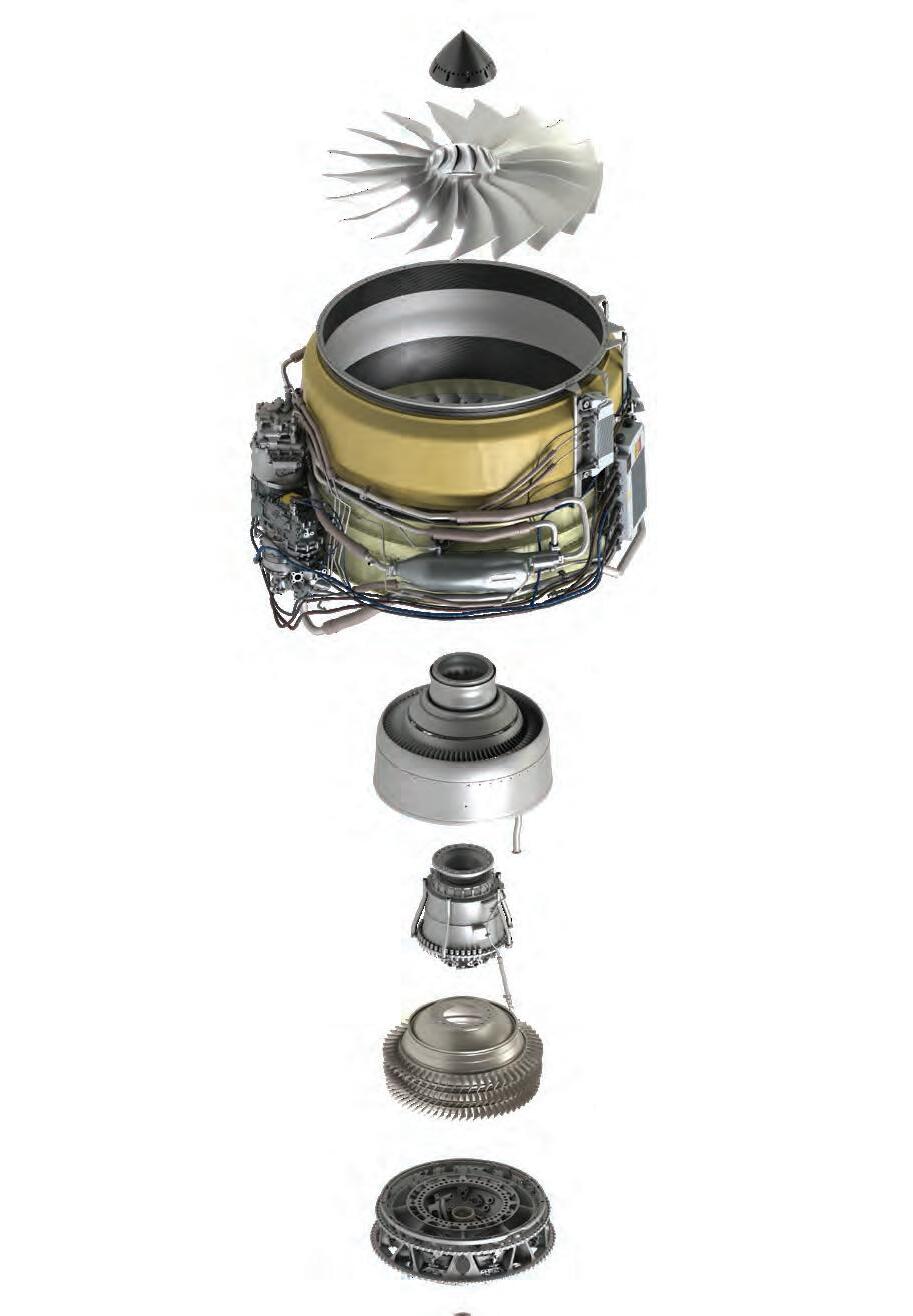

By Charles Alcock
Piaggio Aerospace is making its first appearance at an NBAA-BACE show under the ownership of its new parent company, Baykar. In July, the Turkish defense group completed its acquisition of the Italian aircraft manufacturer, after an insolvency and restructuring process that stretched more than six years.
The distinctive P.180 Avanti Evo twin pusherprop flown to Las Vegas from Florida is one of more than 40 aircraft on the convention’s static display at Henderson Executive Airport. Its presence signals Baykar’s commitment to keeping Piaggio in the business aviation sector alongside developing uncrewed air vehicles and military technology.
Baykar also might have ambitions to revive Piaggio’s planned P.1HH HammerHead
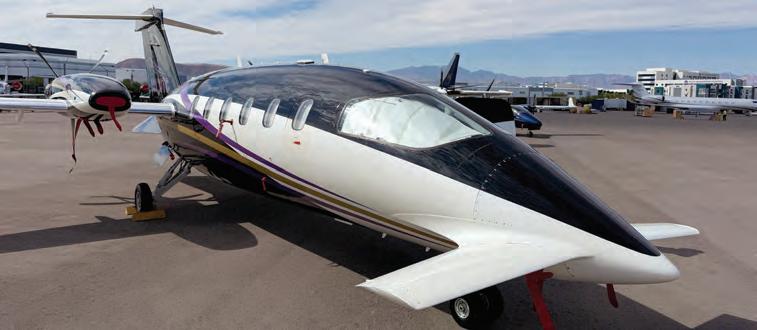
medium-altitude long-endurance drone, which was based on the Avanti airframe.
In September, Italy’s Guardia di Finanza police force ordered a third P.180 Avanti Evo in what was Piaggio’s first aircraft transaction under its new ownership. The takeover by the Turkish group had to be approved by the Italian government, and Piaggio is now led by
Avidyne is unveiling its SkyTrax 3000, a TSO-certified dual-band ADS-B In system, this week at NBAA-BACE 2025. It is engineered to provide Part 25 aircraft with enhanced tra!c alerting and weather capabilities without requiring modifications to existing TCAS II avionics or cockpit displays. An initial STC is planned for the Hawker 800XP/850XP/900XP series, with discussions underway with STC partners for additional aircraft models and avionics configurations.
The system integrates TCAS II and TIS-B ADS-B Intra!c data with ATAS (ADS-B-based tra!c alerting) algorithms and FIS-B weather information, delivering what the company characterizes as a comprehensive situational awareness solution for operators seeking to modernize surveillance capabilities.
“Part 25 aircraft owners and operators have long awaited a cost-e ective dual-band ADS-B In solution,” said Avidyne president Fabrice Kunzi. “The SkyTrax 3000 provides pilots with a complete tra!c picture based on TCAS surveil-
lance as well as 1090 MHz and UAT ADS-B In.”
The dual-band architecture enables the system to receive ADS-B position data from both 1090 and 978 MHz (UAT) frequencies, providing coverage of approximately 38,000 aircraft operating on UAT that would otherwise be invisible to single-band systems. The capability addresses coverage gaps inherent in the FAA’s ADS-R rebroadcast service, particularly at lower altitudes where ground station visibility is limited.
A key di erentiator of the SkyTrax 3000 is its implementation of ATAS alerting, which uses the enhanced data quality of ADS-B transmissions to generate more precise tra!c advisories than legacy TCAS II systems. The technology provides detailed aural annunciations specifying tra!c bearing, altitude relationship, and distance— replacing generic “Tra!c, Tra!c” alerts with callouts such as “Tra!c! Twelve o’clock, Same altitude, 2 miles.”
By extending alerting capability below TCAS II’s minimum alerting altitude of 500 feet agl, the
Giovanni Tomassini, who was promoted from COO to CEO in July.
In addition to private and business transportation roles, Avantis are operated in a variety of governmental and military roles, including surveillance, environmental monitoring, and border protection. The aircraft is also available with an air ambulance cabin interior. z
system uses both direct ADS-B reception and TIS-B uplink data from FAA ground stations. This enables continued tra!c awareness during critical phases of flight where conventional TCAS II systems suppress alerts.
The UAT receiver component provides access to FIS-B weather and aeronautical data, including metars, Nexrad radar imagery, airmets, sigmets, notams, pireps, and winds aloft information—data products that are unavailable to aircraft equipped with only 1090 MHz ADS-B systems.
“The SkyTrax 3000 has been specifically designed to support future software enhancement for ADS-B In applications including SURF, FIM, and CAVS,” said Avidyne CEO Dan Schwinn. The company has fielded more than 25,000 surveillance products across its product family.
Kunzi, who recently testified at the NTSB investigative hearing into the DCA midair collision, noted that “recent events and industry proposals underscore the importance of a robust, future-proof surveillance and alerting system to ensure the safety of the flying public.” J.R.

By Matt Thurber
France-based Airmont and DirecTV In Flight are partnering to deliver the latter’s JetVision live television to business aircraft.
Airmont will optimize the passenger experience by reducing bandwidth consumption per stream, minimizing the number of live feeds open on the internet, and guaranteeing smooth playback, according to the company. Stream-supervision tools also help operators monitor user experience. Onboard equipment such as Innovative Advantage’s AVDS Node is compatible with Airmont’s service.
JetVision’s advantage is delivering live programming without the need for additional equipment. Content can be viewed on cabin displays using streaming players such as Apple TV+ and Roku devices and
laptop computers, tablets, and smartphones. NBAA-BACE 2025 visitors can view a demonstration at the Airmont or Innovative Advantage exhibits.
“Passengers expect the same level of connectivity and live engagement in the air as they do on the ground,” said Airmont executive
chairman Jean-François Gault. “With JetVision by DirecTV now part of our service offering, we ensure that business aviation clients can enjoy this experience, smoothly and reliably, without compromise.”
“Live TV—especially sports and news—has become a defining part of the in-flight entertainment experience for business travelers who want to stay connected,” said Kimberly de Flesco, head of aviation strategy for DirecTV In Flight. “Working with Airmont allows us to further extend JetVision into the business aviation market, helping passengers catch the live TV moments that matter most.” z

Airmont will optimize the passenger experience by reducing bandwidth consumption per stream and guaranteeing smooth playback.
In measuring the performance of in-flight connectivity, the aviation industry has come to accept that peak network speeds do not adequately reflect the quality of a service. To better quantify the overall user experience with in-flight connectivity, Viasat is implementing a new method of performance analytics for its JetXP in-flight broadband service dubbed In-flight Quality of Experience (iQe).
“For years as an industry, we’ve been educating the market to associate single speed tests with connectivity performance, and I think we’ve learned that that’s not really a good metric,” Claudio D’Amico, v-p of business aviation at Viasat, told AIN. “As an industry, we’ve been making decisions on how to equip an aircraft based on a speed test without any context, and I think we need to evolve, and that’s what we’re trying to bring to the market with iQe.”
Viasat’s iQe concept is based on the findings
of a report, “Redefining In-Flight Connectivity in Business Aviation: What Really Matters to Private Jet Passengers,” by the Massachusetts Institute of Technology (MIT) Sloan School. That report, published on Tuesday at NBAABACE, details how business aviation in-flight connectivity providers can translate technical performance metrics into simple measurements that are easy for customers to understand.
“Peak network speeds have been the primary measure of business aviation in-flight

connectivity performance for too long,” said study author Michael Schrage, a research fellow at MIT Sloan.
The iQe metric accounts for multiple variables, including latency, jitter, terminal availability, signal strength, transmission resilience, and demand satisfaction, D’Amico explained.
“We’re in the process of developing a product that measures all of these specific attributes and metrics, and then we’ll launch this through our partners so that customers have access to this information.” This gives customers more transparency and enables them to make informed decisions, for example, about the best times during a flight to plan important business calls, he said.
Viasat is releasing the new iQe concept in the form of a mobile app, as well as a browser-based tool, that will become available early next year for JetXP customers. H.W.

Across every aspect of business aviation, we set the standard for efciency, comfort and connectivity. From engine to fight deck to cabin and beyond, our technologies create a superior fight experience – allowing you to focus on what matters most.
Visit RTX at NBAA, booth 2245
By Jessica Reed
Gogo is advancing its in-flight connectivity offerings with a series of supplemental type certificate (STC) approvals, network infrastructure modernization, and expanded terminal options across multiple aircraft platforms as the company positions itself to meet growing bandwidth demands in business aviation.
Last month, the company secured FAA STC approval for its Galileo HDX (half-duplex) terminal on the Falcon 2000 family, marking the first HDX certification for a Dassault business jet. The modification, developed in collaboration with Dassault Falcon Jet in Little Rock, Arkansas, covers Falcon 2000EX, EX EASy, DX, LX, LXS, and S models.
“The Falcon 2000 is exactly the type of aircraft we developed Gogo Galileo HDX to serve,” said Gogo CEO Chris Moore. Installation requires two line-replaceable units—the HDX antenna and Avance platform—and provides connectivity through Eutelsat’s OneWeb low-earth-orbit (LEO) satellite constellation. Gogo anticipates HDX STC approval for the Falcon 7X by year-end.
In the large-cabin segment, Aloft AeroArchitects received the first Gogo Galileo FDX (full-duplex) STC covering Boeing Business Jet 737NG-based BBJ1 and BBJ2 models, plus BBJ Max variants. The FDX terminal delivers up to 195 Mbps download and 32 Mbps upload speeds and has been installed on BBJ 737. “It clearly demonstrates that Gogo is still the only company that can fulfill every aspect of an aircraft’s operational nose-to-tail connectivity needs from a single resource,” Moore said. A further eight FDX STC agreements are in progress, covering a total of 24 aircraft types.
StandardAero became the first Gogo Galileo dealer to simultaneously complete a pair of STCs, with the FAA approving HDX and FDX paperwork for Bombardier Challenger 600-series twinjet.
Gogo also obtained EASA STC approval for its Plane Simple Ka-band tail-mount antenna on Dassault’s 7X and 8X. The system, which connects to the Viasat Ka-band geostationary GX network, has been installed on a privately
owned Falcon 7X. FAA, Transport Canada, and Brazilian ANAC approvals are expected to follow.
A total of 19 STCs are now complete for the Gogo Galileo HDX terminal covering 24 aircraft types, with 21 more in development. The 40 HDX STCs, either completed or in development through Gogo’s dealer and OEM network, represent an increase from the 38 at the end of the second quarter. Installations are focused on popular airframes including the Bombardier Challenger 300/350 and Embraer Phenom 300. The company is working on approximately 30 additional STCs across its terminal portfolio.
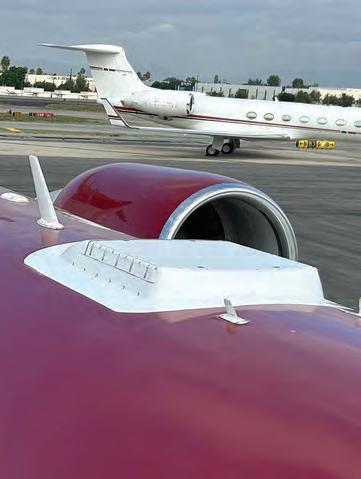
More than 150 Gogo Galileo HDX antennas have now shipped, more than double the 77 reported at the end of the second quarter in 2025. Manufactured by Hughes, the self-aligning, flat-panel electronically steered antenna connects to the Eutelsat OneWeb LEO constellation.
Gogo is showcasing the FDX terminal’s capabilities through a series of demo flights for existing and potential customers at NBAABACE 2025.
Beyond satellite connectivity, Gogo is modernizing its air-to-ground (ATG) network infrastructure with two parallel initiatives.
The company’s new 5G ATG network features 170 towers capable of peak speeds up to 80 Mbps. “5G, true broadband services for ATG, 30 Mbps plus service…That network’s already been deployed from a ground perspective,” Moore told AIN.
Gogo is advancing its 5G air-to-ground journey, with anticipated testing transitioning from terrestrial validation to on-wing trials in the coming weeks. The company is pre-provisioning aircraft daily, with more than 400 aircraft already pre-provisioned with the MB13 antenna and Avance LX5 router required for 5G access. The 5G network is expected to become operational in the first quarter of 2026.
Simultaneously, Gogo is upgrading its legacy Gogo Biz Network to LTE technology through FCC-funded modernization efforts. The LTE network, comprising 256 towers, will replace the company’s original ATG network launched in 2008. “Our LTE network is really modernizing our classic network, being funded by the FCC; the reason for that is modernization of the network, removing some foreign components from that,” Moore explained.
The LTE transition requires mandatory hardware upgrades for all aircraft equipped with classic ATG 1000, 2000, 4000, 5000, and 8000 systems, as well as early Avance platforms. After the May 2026 cutover, legacy equipment will no longer function. Gogo is offering a $35,000 rebate on its C1 LRU replacement unit for customers who commit before Dec. 31, 2025.
Gogo’s LEO service, branded Galileo, is expanding with both HDX and FDX terminals offering 60 Mbps and 200 Mbps capabilities, respectively. “FDX [offers] the full capability of the Eutelsat network,” Moore noted. The company’s geostationary services using Kuand Ka-band continue showing year-overyear growth.
Moore highlighted the low-latency advantages of LEO connectivity for video conferencing applications, noting that operators increasingly prioritize productivity during flight time. z
By Matt Thurber
More than 300 employees and guests celebrated the opening of Liebherr-Aerospace Saline’s new building at the company’s campus in Saline, Michigan, earlier this month. The 33,000-sq-ft facility adds to Liebherr-Aerospace’s OEM equipment testing and MRO services, including work on landing gear and pneumatic components.
Heat-transfer components manufactured by Liebherr-Aerospace are installed in commercial airplanes, helicopters, and business jets, including those manufactured by Airbus, Boeing, Bombardier, Embraer, and Mitsubishi.
“The positive and overwhelming acceptance by our customers has allowed us to expand our offerings worldwide,” said Liebherr-Aerospace Transportation chief customer officer Alex Vlielander. “Furthermore, by expanding the network, we are shortening
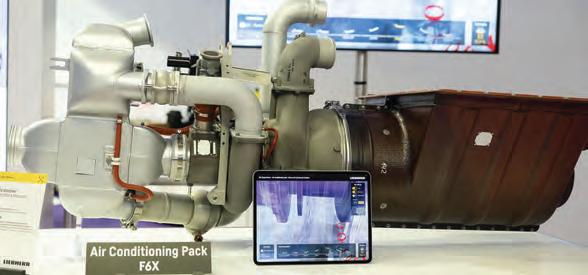
the overall turnaround time by eliminating transportation time.”
“It is also important that we recognize the sustainable contributions of our employees. This milestone is proof of their daily contribution to our success,” added Will Dew, managing director commercial at Liebherr-Aerospace Saline. “Thanks to their tireless commitment and the new local conditions that the new
A 33,000-sq-ft facility was added to the company’s campus in Saline, Michigan, expanding its capacity for work on landing gear and pneumatic components.
building provides us with, we can respond even more quickly to the growing demand”
At its NBAA-BACE exhibit, Liebherr is highlighting its expertise in manufacturing landing gear and integrated air management systems. On display is a nose landing gear for Embraer’s Legacy 650. Liebherr’s integrated air management system for Dassault’s Falcon 6X is also on display. z

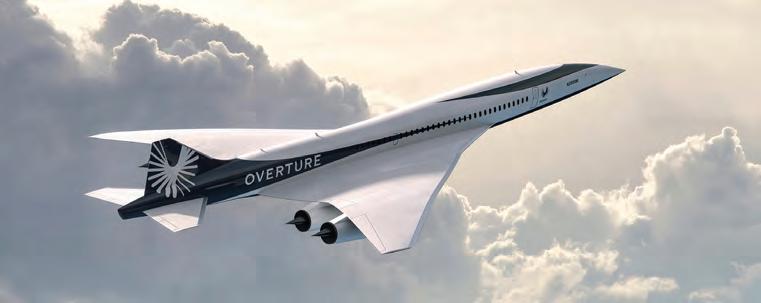
The company is focusing on developing boomless supersonic commercial airliners.
By Hanneke Weitering
A somewhat unusual exhibitor for a business aviation trade show, Boom Supersonic is making its debut at NBAA-BACE this year. The Coloradobased startup, which is developing a boomless supersonic airliner, insists it has no plans to produce a supersonic business jet—at least not yet.
“Boom does not currently plan to build business jets, but we are supportive of opening up competition in the space,” a company spokesperson told AIN. “With so many developments and milestones toward the return of supersonic travel in 2025, now is a great time to engage with this audience.”
During flight tests earlier this year, Boom’s XB-1 supersonic demonstrator aircraft broke the sound barrier six times without creating an audible sonic boom on the ground, successfully demonstrating
what the company calls “boomless cruise.”
According to Boom, the 60- to 80-passenger Overture supersonic airliner will enable flights up to 50% faster over land and twice as fast over water.
“We believe that XB-1 demonstrating a practical solution for sonic booms will lead to innovation in the broader industry, and it has already influenced the regulatory landscape for supersonic travel,” Boom’s spokesperson said.
In June, President Trump signed an executive order directing the FAA to repeal a 52-year ban on supersonic flight over land in the U.S. and to establish new aircraft noise certification regulations. “Lifting the ban will drive innovation in supersonic travel, not only for commercial but also for business jets focused primarily on overland routes,” the spokesperson said.
“Boom is focused on commercial airliners, but we do believe the repeal of the supersonic overland ban will unlock innovation and
Universal Aviation has signed a major agreement with Saudi Arabian o cials, expanding its footprint into the Middle East for the first time with the establishment of three new facilties. The company’s Saudi division, led by general manager Hayel Altashkandi, has begun preparations to open a lounge in the shared general aviation terminal at Riyadh King Khalid International Airport (OERK) in early 2026.
Universal also received concessions by stateowned airport operator Matarat Holding to manage facilities and provide full ground-handling services at Jeddah King Abdulaziz and Dammam King Fahd international airports.
“This is a long-term investment for Universal,” said Altashkandi. “Our goal is to raise the standard of private aviation services in the kingdom by combining Universal’s global experience with the passion and hospitality of our Saudi team.”
At OEJN, Universal will operate as one of three approved providers, taking over an existing private aviation terminal and operating its own facility and lounge within. In both cases, the award includes the operation and management of the first hangars dedicated to private aviation in the kingdom. At all three locations, Universal will o er
competition in both the commercial and business aviation space.”
“Now that supersonic flight is allowed over the U.S., a supersonic business jet absolutely should exist,” they added. “Boom would gladly license our ‘boomless cruise’ technology—which includes the Symphony engines—to anyone interested in making this product.”
Boom is developing its own Symphony turbofan engines for the Overture, and the company plans to begin ground tests soon in a new facility it is building at the Colorado Air and Space Port.
“Building Overture…remains our primary objective,” the spokesperson told AIN. “Overture 1 is the first supersonic airliner in the family of aircraft Boom plans to build to meet the global demand for supersonic travel. Just as we expect fares to come down over time as demand grows, future iterations of Overture will evolve to meet the needs of the market and our customers.” z

The company will establish a trio of FBOs in Saudi Arabia starting in early 2026.
modern private lounges; expedited customs, immigration, and quarantine facilities; and concierge and ground services. Universal has more than 50 locations worldwide. C.E.
By Amy Wilder
Nevada-based charter operator Thrive Aviation has doubled its managed fleet from 13 to 30 aircraft in 18 months by adopting financial services provider MySky’s automation platform, the companies announced.
By centralizing its financial processes, Thrive was able to shorten its monthly close by five business days, reducing data entry errors by 20%, and halving receipt review time. The company reports that vendor and fuel procurement savings exceed $200,000 across the fleet, allowing it to attract new aircraft owners with transparent reporting and cost control.
“There’s no way we could have scaled this quickly if we had stayed in spreadsheets,” said Curtis Edenfield, co-founder and CEO of Thrive. “MySky unlocks operational capacity and foresight, simplifies workflows, and gives

us the automation we need to grow.”
Jean-Sebastien de Looz, COO of global SaaS at MySky, said, “Thrive is a perfect example of what happens when operational ambition meets financial clarity. Its ability to scale rapidly without sacrificing control or service quality is testament to the power of automation, transparency, and partnership.”
Thrive now ranks among the top charter
Thrive Aviation COO Rickey Oswald, left, shakes hands with Thrive CEO and co-founder Curtis Edenfield.
operators on Private Jet Card Comparisons. It credits MySky’s technology in helping its growth.
“Our partnership with MySky goes beyond technology,” said Rickey Oswald, COO and partner at Thrive. “The MySky team is responsive, proactive, and invested in helping Thrive deliver on its brand promise. It is a level of support that is rare in the software space.” z

EAP is celebrating our ninth year and we’ve added more engines and APUs from GE, Honeywell, Pratt & Whitney Canada and Rolls-Royce to our hourly engine maintenance program.
By Matt Thurber
Aerospace Technologies Group (ATG) introduced its AerLuxe window shades at the AIX show in Hamburg in April, highlighting how they replace individual window shades with a single panel that blends with the interior and offers both light-filtering translucent and
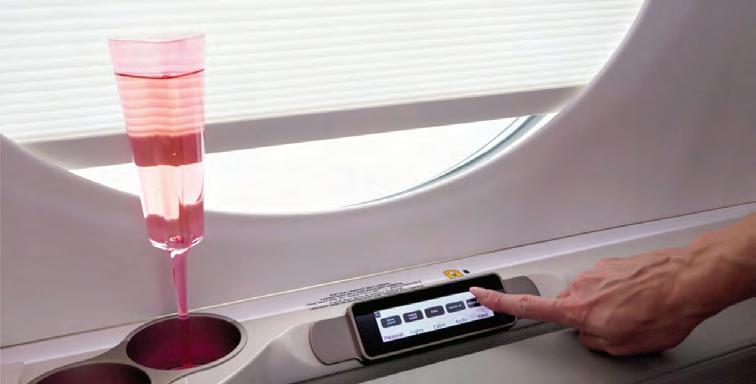
cabin-darkening opaque modes. The shades, which replace ATG’s MS2 and MS3 product lines, are on display this week at the company’s NBAA-BACE exhibit.
Electronic controls make operating AerLuxe shades easier and connect them to maintenance information and cabin management systems. This enables operators and maintainers to tap into performance metrics, remote diagnostics, and software updates without removing the shade from the aircraft, according to ATG. “The advanced electronic controls feature self-learning
AerLuxe window shades include electronic controls that can share data with maintenance and cabin management systems.
algorithms and sensor-less control to extend the shade life and provide the quietest operation.”
ATG offers an optional ShadePT feature that helps the shades last longer using a preventive maintenance function. This works with the shades in place, returning them to their original shape, and can be activated by the cabin crew.
AerLuxe shades will be available for a variety of business jet, bizliner, and airliner applications. According to ATG, window shades can easily be replaced during heavy maintenance checks and cabin refurbishments. z
After introducing the latest addition to its portfolio—the Jet-X headset—for jet pilots earlier this year, David Clark is o ering a discount on the active-noise-reduction (ANR) version for purchasers who buy the headset directly from the company. The Jet-X headset, along with other David Clark products, is on display this week at the company’s NBAABACE exhibit.
Unlike headsets with full over-ear earcups, the Jet-X is an on-ear design for pilots flying business jets and airliners with quieter flight decks. “It complements the OneX and the Pro-X2,” said Ken Times, aviation business development manager. “Now we have headsets available for loud, medium, and quiet cockpit applications.”
To keep the price of the Jet-X headset at a more attractive level, it doesn’t have Bluetooth capability. Like all David Clark headsets,
the Jet-X meets technical standard order (TSO) C139a criteria, which some airlines require of headsets used by their pilots.
Weighing just 4.5 ounces, the Jet-X has a polymer headband and adjustable suspension system with a heat-absorbing head pad and leatherette ear seals. Buyers can opt for David Clark’s electronic noise-canceling technology with the ANR version or pay substantially less for the Jet-X without ANR. Other features include an M-5B electret noise-canceling microphone with a flexible boom, a controller powered by one AA battery that lasts for up to 50 hours of continuous use, and an automatic shuto feature to preserve battery life.
At its NBAA-BACE booth, David Clark personnel are available to demonstrate the headsets and provide new ear cushions to David
David Clark’s Jet-X headset comes in noise-canceling and passive configurations.

Clark headset customers. “We always have plenty of ear cushions to supply to visitors,” said Times, and his team members will help replace cushions for customers who bring their headsets.
David Clark is o ering discounts of $50 to $80 o for factory-direct orders for the Jet-X ANR and OneX and Pro-X2 headsets. Headsets are available with various connectors, including dual GA, five-pin XLR, and sixpin LEMO. M.T.
By Charles Alcock
Charter flight platform Avinode, which has been tracking and supporting the global private aviation market for more than two decades, views current conditions as generally encouraging from the point of view of all stakeholders. Over the past three years, the company has seen the strongest growth in terms of numbers of business aircraft listed in its charter marketplace from the Middle East region (up 45%), followed by Asia-Pacific (+40%), the U.S. and Canada (+30%), and Europe (+10%).
“In the U.S. market, we’re seeing record numbers of [charter] operators, brokers, and aircraft on the platform, so that does look healthy to us, and clearly it is a market where people want to sell charter,” Harry Clarke, Avinode’s director of commercial development, said. “Right now, overall it feels like a stable situation in terms of demand and the desire to travel with a good supply to demand balance. In recent years, we have been used to giant swings.”
According to Avinode, charter operators and brokers are increasingly willing to invest in innovative technology to make their businesses more productive and profitable. Key factors can be achieving better pricing for flights and creating time to focus on customer service.
Clarke told AIN that average charter prices in the U.S. have been relatively flat. In his view, this gives well-run operators an opportunity to exploit “differentials” if they have the right data to prepare quotes.
One trend identified by Avinode’s data on flight requests is rising demand for eastbound transatlantic flights from the U.S. to Europe. For the past three months, these inquiries have been up by 17% and are set to be 16% higher than the same period last year for the fourth quarter. The company sees generally somewhat weaker demand in Europe, and especially in some particular markets such as Germany.
Strength in the U.S. market is also having other knock-on impacts in wider international markets, according to Avinode’s flight request data. “For instance, since the start of this year,
we’ve seen a 20% increase in local Asian operators listing their aircraft in countries like Thailand and Indonesia, and this means U.S. charter brokers can benefit from availability elsewhere,” Clarke explained.
“Brokers still have a key role to play, and especially if they are using technology to support their role in making air charter travel a highvalue experience, making sure they can deliver the right options to customers,” Clarke said. z
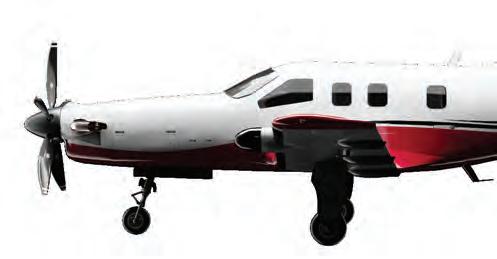

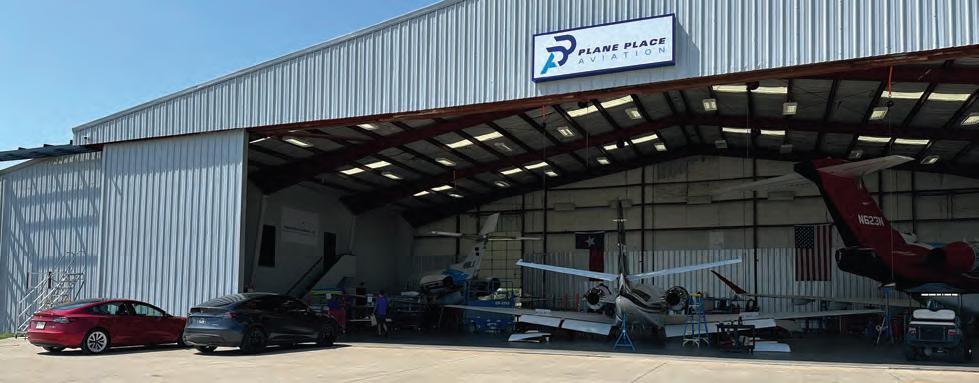
By Matt Thurber
As aircraft wind down their useful service lives, the number of maintenance shops that specialize in legacy models dwindle and the cost of maintenance climbs significantly, making continued ownership a challenge. Yet many aircraft are built to last much longer— for example, midsize Hawker twinjets—and they remain popular, with acquisition prices low enough to keep them attractive.
Plane Place Aviation, based in Cleburne, Texas, is one facility that has embraced the challenge of keeping Hawkers flying, both with the latest maintenance techniques and by parting out older airframes to maintain parts supply. Plane Place said demand has never slowed down since it was founded by Tristan Noe and Travis Roberson in March 2022.
“A lot of that has to do with trust and customer service,” said Noe. That trust is amplified because he and Roberson continue to lead maintenance projects and work directly with customers. “All managers are involved,” he said. “If we get a phone call at 12 a.m., you’ll reach somebody here, not a salesperson.”
In addition to Hawkers, Plane Place has branched into Bombardier Challenger 300s and 350s and some Cessna Citation models. The Challengers are good business because they are popular charter platforms—when one breaks down it needs to be fixed quickly to get the airplane back into service.
Starting with one hangar in 2022, Plane Place has grown to three at Cleburne Regional Airport (KCPT), with each hangar specializing in one airplane type. Another hangar, spanning 50,000 sq ft, was added to the Plane Place campus last month, and this will be focused on teardowns for parts reclamation for Plane Place’s in-house parts operation, Texas Aircraft Parts Brokers.
While Cleburne, about an hour from the Dallas area, might seem like a difficult locale to attract employees, Plane Place has seen a surge of interest from mechanics who are tired of the Metroplex traffic. Even if they live outside Cleburne, the drive to work is much shorter and less stressful than driving to Dallas or Fort Worth, Noe explained.
“It’s still tough to get people,” he admitted, adding that Plane Place’s family atmosphere helps. “A lot of us are friends and we hang out
Plane Place Aviation at Cleburne Regional Airport in Texas helps owners keep their Hawker jets flying and also maintains Cessna Citations and Bombardier Challenger 300s and 350s.
outside work. My family is involved; my dad and sister work here.”
Plane Place hires experienced mechanics, those fresh out of A&P school, and nonlicensed people who want to earn their A&P through on-the-job experience. In the latter case, Plane Place will not only help with providing the necessary training and experience but also pay for testing.
Once a month, Plane Place holds a training session to discuss lessons learned, quality escapes, and tips and tricks. Mechanics also get sent out for formal training.
To help mechanics with the inevitable paperwork and logbook entries involved in aircraft maintenance, Noe hired a firm to help create an AI-based tool that taps into the EBIS maintenance management software that the company uses. The first iteration of the tool allows mechanics to talk into their phone to capture the work description for invoicing.
Another tool under development will help with preliminary research for airworthiness directives, service bulletins, FAA 8130 parts tags, and part numbers. “We hope to save mechanics time and be more efficient,” Noe said.
At NBAA-BACE, Plane Place is highlighting its recent approval by Mexico’s AFAC as a certified repair station, enabling the MRO provider to expand services for operators of Mexicoregistered aircraft. Plane Place offers airframe inspections and maintenance, structural repairs, pre-purchase inspections, 24/7 AOG assistance, and maintenance management, as well as engine, avionics, wheel and tire, battery, and additional accessory capabilities for Challengers, Citations, and Hawkers. z

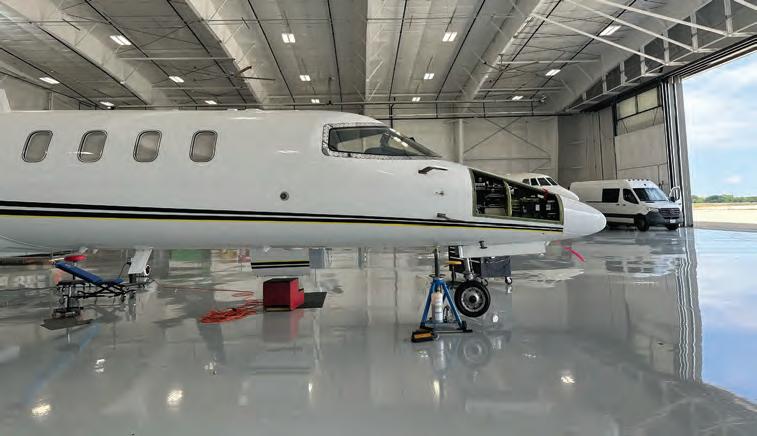
By Matt Thurber
Nearly two years since Suresh Narayanan launched business jet maintenance company Jets MRO at Dallas Executive Airport (KRBD), business is growing, mechanic turnover is low, and the company is the largest employer at the formerly underutilized airport.
Earlier this year, Jets MRO moved from a smaller hangar at KRBD to a new, purpose-built MRO facility on the south, undeveloped side of the airport. Part of the Jets MRO plan includes adding another hangar in the next three years, and Narayanan hopes the company will become the largest independent business aviation MRO in the Southwest U.S.
Coincidentally, an A&P school—Dallas College—moved into Jets MRO’s old facility at KRBD, giving graduates first-mover access to Narayanan’s company.
Hiring is about much more than access to qualified personnel, however, and Narayanan has a mandate to figure out how to retain great employees as one means of tackling the shortage of mechanics.
This starts with making the facility a comfortable place to work, and the purpose-built hangar certainly helps. In addition
to well-equipped back shops, a flawlessly clean floor, and all the necessary tools, the hangar is air-conditioned, not to frigid temperatures but to a maximum of 20 degrees F cooler than outside, which dries out the humid Dallas summer atmosphere and also provides a significant measure of comfort inside the hangar.
Keeping customers happy depends on a happy workforce, and Narayanan often comes back to that topic. He is involved in the hiring process from the beginning and screens potential employees to make sure they match Jets MRO’s values. Once hired, he said, “My job is to help the team.” Voluntary turnover is just 6%. “We look at it as it’s someone firing us,” he added. “It’s hard on us.”
All employees participate in internal surveys, one-to-one meetings every month, and frequent meetings to discuss issues. Jets MRO shares financial and operational performance with employees and even made its technician payscale public so prospective and current employees could see how they can progress at the company. There is also no forced overtime or on-call requirements; these are optional. “It just burns people out when you push too hard,” he said.
Narayanan likes to share information with other MROs to help improve the industry for all participants. To that end, he is participating in a panel session tomorrow at 2:30 p.m. at NBAA-BACE, titled “Retain to Gain: Leadership Strategies for Keeping Mechanics and Maintenance Team Members.”
Another factor in Jets MRO’s growth is consistency. This means being selective on the aircraft types that it will work on and not trying to satisfy every potential customer. The lines of aircraft Jets MRO services include Bombardier’s Learjet 40/45 and Challenger 300 and 600 series, as well as certain Cessna Citation models. “We love the idea of maintenance consistency,” Narayanan said.
This expertise not only helps with mechanic training and parts supply consistency but also encourages repeat customers. When customers come back, he explained, the reliability of their aircraft soars, as opposed to hopping from shop to shop in search of the lowest prices. In any case, high reliability ultimately equates to lower costs.
Narayanan understands the importance of reliability and aircraft availability, having worked for a large charter operator. Delivering aircraft after an inspection event on time is critical, and Jets MRO enters into professional service level agreements with operators, guaranteeing on-time delivery, or if late, refunding 7% of the cost of the job.
On-time performance doesn’t just mean delivering when promised, however, because a problem after the delivery could affect the aircraft’s uptime. So Jets MRO tracks the performance of its customers’ aircraft for 30 days after completing the job. If something happens and it’s Jets MRO’s fault, it takes responsibility and doesn’t count that as an on-time delivery.
This kind of service commitment and the quality of work are attracting a lot of business, such that Jets MRO is open and staffed seven days a week. Consequently, Narayanan said, “We turn away a lot of work. It’s the right thing to do if you want to deliver on time.”
In January, Jets MRO will celebrate its twoyear anniversary. “Starting any business and growing it is like getting punched in the face,” Narayanan said. “Maintenance is very technical. It’s hard. I thought it would be easier by miles. Every day I continue to learn.” z
SDC2026 is the industry’s premier business aviation scheduling and dispatching event! Offering unmatched opportunities to explore the latest dispatch technologies and connect with thousands of industry professionals, this leading event is designed to drive your flight department operations and career toward success. If you’re ready to expand your network, uncover new sales leads, and invest in your success, this is the event for you. Don’t miss out!


One of the key questions in the BJT 2025 Readers’ Choice survey is what kind of aircraft readers would choose to fulfill their business and pleasure travel needs. The responses highlighted some interesting trends.
If you could regularly fy on any of these aircraf, which would you choose in each category?
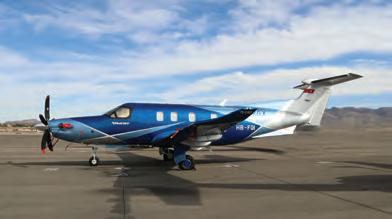
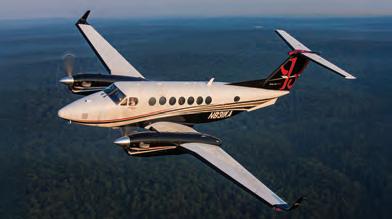
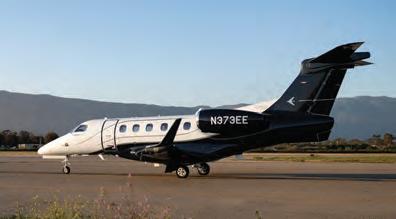
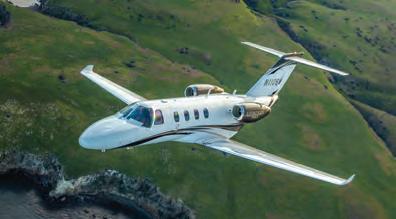
Join us for lunch!
Wednesday, October 15, 2025
NBAA-BACE | Las Vegas, NV | 12:00–1:30 pm PT

Seating is limited so register today!
The 2025 NBAA Luncheon, co-hosted by Honeywell Aerospace and Viasat, brings together leaders in business aviation to explore the future of in-flight connectivity.
This exclusive event will feature key updates from both companies, highlighting innovations that are shaping the passenger experience and operational capabilities in the skies.
Attendees will gain insights into Honeywell’s next-generation JetWave X solution and Viasat’s advancements in satellite technology, plus a collaborative study with MIT on business aviation connectivity trends.
Lunch will be served. Panelists include:

Jason Wissink President


connect.ainonline. com/ain-nbaa-2025
Honeywell Services & Connectivity
Kai Tang Head of Business Aviation Viasat
Michael Schrage Research Fellow
MIT Sloan School of Management

Hosted by: Sponsored by:



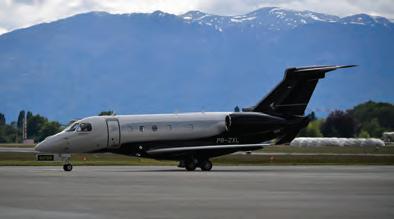
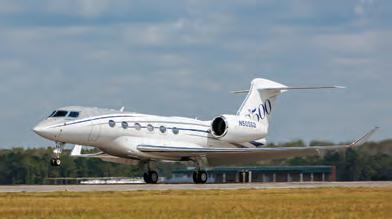
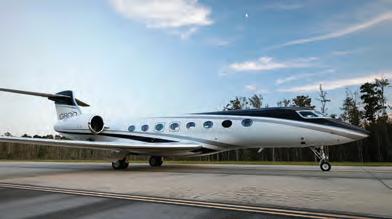

By Charles Alcock
Floating Fleet AI is now offering charter operators and brokers what it claims is a quantum leap in terms of the speed at which they can schedule available aircraft for flights. According to the U.S. start-up, by tapping artificial intelligence (AI) to drive fleet searches, it has reduced the task to just a few seconds.
The platform is the brainchild of founder Roger Zahn, who has worked in private aviation since completing his doctorate in 2006 at the University of Florida. After starting with CitationShares, Textron Aviation sent him to China for a couple of years to help develop the market there, and he later led data services for both Wheels Up and Wayfair Professional.
According to Zahn, Part 135 operators need more effective help managing both their aircraft and their crew members. Floating Fleet’s promise to them is that it will come up with the shortest path to maximizing capacity and, by extension, return on investment in a very competitive marketplace.
The platform, which the company says can be integrated with most flight management systems, got its first paying customer in February and now supports more than 45 aircraft. “Humans can do this work, but not fast enough,” Zahn told AIN, claiming that rival platforms take several minutes to complete the same tasks. “The heart of the problem is working out how [for example] 20 aircraft could operate 100 flights over just a few days, and our system also handles crew assignments and gives fleet planning windows and projected savings.”
Floating Fleet’s AI component can be trained to take into account multiple variables noted by each operator based on past experience. For example, if an aircraft owner or charter customer is routinely late, the system will take that into account when allocating equipment. The core data tracked by the platform is where an aircraft is, where it is due to be next, and the qualifications and status of available flight crew.
“It’s there to help the human scheduler have more time for what they are good at, which is understanding the priorities of the customer and responding to them,” Zahn explained. “For the sales team, it can assess all the costs and show optimum pricing with margins for multiple scheduling options, taking account of factors such as the need to relocate aircraft and looking for efficient pairs or sequences o f flights.”
According to Floating Fleet, the system is suitable for any operator managing five or more aircraft flying 400 or more hours each year, and with more than 15 pilots. It can also help air charter brokers generating more than $50 million in annual revenues, which Zahn said equates to around five or six flights every day.
The company aims to have more than 100 aircraft listed on the platform by year-end.

By analyzing variables that affect flights, aircraft location, and crew availability, Floating Fleet AI can help charter operators optimize their fleet capacity.
Zahn and his team are integrating the technology with more third-party systems and working with operations software provider MyAirOps. z

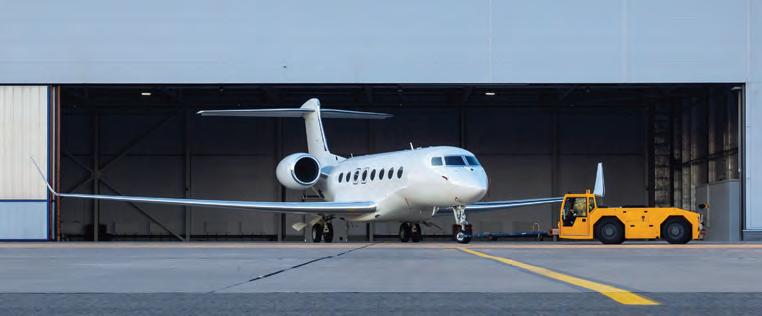
Unpredictable volatility from Washington, D.C., could have far-reaching effects for business aviation.
Report by Curt Epstein, charts and data by Dave Leach
For the FBO industry, aircraft movements are its lifeblood, and 2024 proved to be a stable year for business aviation. While the 3,630,600 business jet and turboprop departures in the U.S. were just a percentage point off from the previous year, they were still 23% above pre-pandemic totals, according to data from industry data analyst WingX Advance.
For Europe, departures were down less than 1% from 2023 and still nearly seven points above 2019 numbers. In the Caribbean region, however, business was booming: activity was up by 9.4% last year.
In terms of industry consolidation, while the number of FBO transactions was down from the dizzying heights of recent years, it remains a seller’s market. “While the industry has largely moved on from the record-breaking acquisitions of the two largest chains by private equity in 2021, these transactions captured the imagination of many FBO owners considering selling the past few years,” said Douglas Wilson, president and senior partner of industry consultancy FBO Partners.
“Those sellers adjusted their valuation expectations accordingly, yet unscientifically.” Those inflated asking prices, higher interest rates, and decreased inventory of highly attractive top-tier locations could all serve to cool down what had been a busy FBO consolidation market. “Adding to the transactional
malaise is an unusually large pool of would-be aggregators,” Wilson said.
Over the past few years, players such as Lynx FBO and Ross Aviation were absorbed by Atlantic Aviation, while Tac Air was acquired by Signature Aviation. However, others such
as Modern Aviation, Skyservice, AeroCenters, a revamped Odyssey Aviation, and newcomers to the market remain to take their place in the FBO acquisition ecosystem.
While Wilson expects a relatively robust mergers and acquisitions market for 2025, he cautions that unpredictable volatility from Washington could have far-reaching effects. “The potential loss of thousands of government employees who regulate the industry will slow transactions.”
One major development in the U.S. FBO industry this past year was in the geographic expansion of the sustainable aviation fuel (SAF) supply. While SAF availability had been limited to the West Coast, a series of announcements from producers such as Neste and distributors such as World Fuel Services and Avfuel last year saw it flow steadily eastward as new distribution terminals were established.
With that backdrop, AIN tasked its readers to rate the FBOs they frequent in five categories. To reach the top rungs of facilities worldwide in the survey, it’s not enough for an FBO to score highly in just one or two categories; the top-rated facilities must show consistent quality across all five areas. z
Aircraft operators and other FBO users can rate airport service providers they frequent worldwide in five categories— line service, passenger amenities, pilot amenities, facilities, and CSRs—as well as give a shout out to facility sta ers who went above and beyond in providing great service.
The results will be announced at AIN’s 2nd Annual FBO Awards Dinner & Gala on March 26, 2026, and will appear in the April 2026 issue of of Aviation International News.
FBO Survey respondents will be entered to win a $250 gift card.
For more information on AIN’s FBO Awards Dinner & Gala visit AINFBOAwards.com
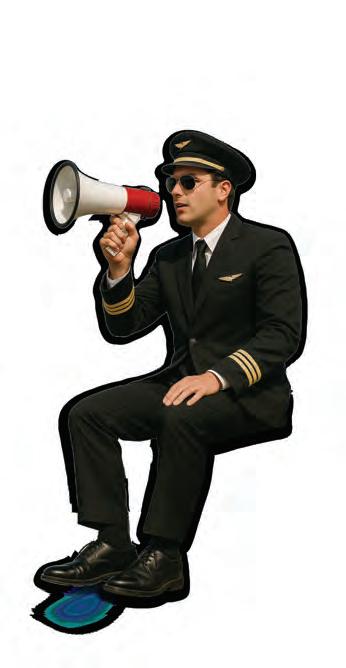

To access the survey and record your votes, visit: FBOSurvey.com

While Lufthansa’s Lockheed Constellation won’t fly, it has been restored to impeccable condition.
By Curt Epstein
After 18 years, Lufthansa Technik (LHT) is finally putting the finishing touches on one of the most ambitious aircraft maintenance projects in its history. In the mid-2000s, parent company Lufthansa Group’s Deutsche Lufthansa Berlin-Stiftung (DLBS) historic flight foundation decided to add a Lockheed 1649A Super Star to its fleet of flying museum pieces, which included the Junkers Ju-52/3M.
As the final iteration of the successful four-engine Constellation family, and marking the end of the piston-engined passenger airliner era, the L1649A joined the Lufthansa fleet in 1957 on the nonstop transatlantic route between New York and Hamburg. Four of the aircraft (out of the 44 built) served until they were superseded by the Boeing 707 in the mid1960s. The Super Star saw the inauguration of the airline’s first-class “Senator” service with an onboard chef catering to the 32 passengers who endured the nearly 15-hour flight from the comfort of sleeper beds and nearly lie-flat seats.
As the aircraft were eventually retired from service, a private collector in Maine acquired three of the survivors. He had two flown to Auburn/Lewiston Municipal Airport (KLEW), his home field, while the third, in Florida, was never able to be fixed up enough to make the ferry flight north. DLBS purchased the three airframes, more
than a dozen massive R-3350 Wright turbo-compound radial engines, and a trove of spare parts with the goal of fielding one airworthy example.
The city of Auburn, Maine, built a hangar for the LHT crew to work on the airframe that was selected for restoration to make it airworthy. Regarding the other two aircraft, one is in the Fantasy of Flight collection in Polk City, Florida, while the other serves as an outdoor cocktail lounge at the TWA Hotel at New York JFK International Airport.
“As you can imagine, the aircraft were in very bad shape after such a long period,” said Oliver Sturm, who has been with the program since 2008 and is leading the restoration project. “I think the last time it flew was at the end of the 1980s. It was stored in Maine, and the weather on the East Coast is a lot of rain and snow. The structure at the end was so bad we had to replace nearly every panel on the aircraft, so the structure is brand new, I could say zero-flight hours.”
The work was done by a small group of dedicated LHT technicians, supplemented by retired workers and trainees. It continued for a decade, even enduring an accidental hangar foam suppression discharge that ruined reams of paperwork and volumes of documents. While that set the project back by several months, only the structural portion of the aircraft was in the hangar during the discharge,
and all components were fortunately crated in a nearby warehouse.
By 2018, the company faced a reckoning of what it would take to recertify the aircraft in terms of time, with estimates of the project dragging on for another five years at the then pace of work, but in the summer of that year, the fatal crash of another operator’s historic aircraft—a tri-motor Ju-52 during a sightseeing tour in the Swiss Alps that claimed 20 lives—caused European authorities to institute tighter scrutiny for vintage aircraft flights. That was the final straw; Lufthansa officials then decided to abandon plans for the Super Star’s return to flight, opting instead to prepare it for static display in honor of the brand’s 100th anniversary in 2026.
After another brutal Maine winter, the airplane—disassembled into four large pieces, along with more than 300 crates of parts and components—was loaded on flatbed transports in early 2019 and trucked to nearby Portland, Maine. Once it was transferred to a cargo ship and sent to Bremen, Germany, the airframe was placed in storage until 2023, when it arrived at the LHT facility in Hamburg for the restart of the restoration program.
Preparing the L1649 for display rather than flight was a weight off the restoration crew’s backs. “The big difference is if you don’t have to follow any regulations, you don’t need engineering, you don’t need paperwork, and so on,” Sturm told AIN. “It makes it much, much easier to go ahead.”
Yet, that doesn’t mean the work would be conducted with any less dedication or attention to detail. “Because we are all engineers, mechanics, and sheet metal workers, we do the


JANUARY 15 - 17, 2026
“The AIN CALS event has been a refreshing experience for leaders within the corporate aviation community and the vendors that support their businesses. 100% engagement for 2.5 days. Truly a working event that leaves us all a bit tired but very enthused!”
– CALS FLIGHT DEPARTMENT ATTENDEE
“The AIN CALS event provides excellent opportunities for high level interaction between vendors and clients. The one-on-one time and small group sessions are very valuable settings.”
– CALS SPONSOR
job as if it were a flyable aircraft at the end,” he added. Among the surprises Sturm encountered during the course of the project was the realization that the Connie’s wings were each attached to the fuselage by just eight big bolts.
At the end of the second quarter, the reassembled Super Star was rolled out of the hangar at Hamburg and was greeted by a sea of more than 2,000 cheering company employees and guests.
“That gave me goosebumps,” said Sturm. “If you ever want to see grown-up guys with tears in their eyes, that would have been the moment.”
The aircraft was once again disassembled and trucked to Münster/Osnabrück Airport, where the four subassemblies were given the vintage Lufthansa “parabolic” paint scheme
that the type wore during the 1950s and 1960s. The work was carried out by Altitude Paint Services, with Hamburg-based manufacturer Mankiewicz providing around 500 liters of special paint free of charge.
Still in subassembly form, the Constellation was then moved to Frankfurt, its final destination. Once reassembled for the last time, it will be the centerpiece in the new visitor and conference center under construction at the Lufthansa Group’s headquarters, along with the 1930s-era Ju-52.
Although regulations require the L1649A to be entirely drained of fluids before going on display, Sturm said that will be virtually the only concession in terms of functionality. “If
somebody goes to the new visitor center and looks at the aircraft, they should have the feeling that the aircraft is in flyable condition,” he explained. “If you look into the landing gear, every hose, every tube in it, every cable is installed.”
That same level of detail goes for the cockpit as well. Since the airplane will not return to flight and did not have to incorporate any modern avionics to meet regulatory standards, the front office will be representative of 1950s technology. As for the cabin, LHT prefers to keep that under wraps until the formal unveiling of the Super Star next year during the centennial anniversary, noting only that it will have a functional 1950s coffee maker in the galley. z
London Biggin Hill Airport (EGKB) achieved a significant milestone in its ongoing improvement program with the completion of runway resurfacing last month. The upgrade has resulted in a regrooved surface that now features new lighting and an improved runway visual range on the Runway 3 approach.
According to the privately-owned airport, which is entirely dedicated to business aviation operations, the £20 million ($27 million) investment has removed operational restrictions in wet weather conditions. Bombardier and Gulfstream have both made changes to standard operating procedures to reflect the new levels of safety. Notably, the resurfacing used a bio-bitumen asphalt binder made from renewable materials.
The investment has substantiated Biggin Hill’s commitment to corporate operators complaining that the airport infrastructure was not adequate. Other improvements include the 24/7 availability of Metar weather data, which gives transatlantic operators in particular a higher degree of certainty about using the airport because they can be sure of weather conditions on arrival.
One regular customer commutes from New York City to London’s financial district, landing every Monday morning at 6:40 a.m. He takes the first available helicopter shuttle service, op-
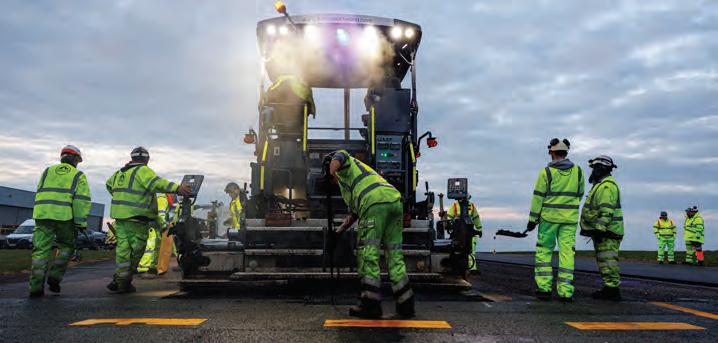
erated by Castle Air, at 7 a.m. and is at his desk by 7:30 a.m. The client makes the same trip in reverse every Thursday evening, taking o for the westbound flight at 10:30 p.m. each week.
According to Biggin Hill’s marketing team, its landing fees and other service charges are significantly lower than those of some alternative airports in and around the UK capital. For instance, they quoted a £200 landing fee for a Pilatus PC-12 turboprop, saying that this is a third of what Farnborough Airport charges.
In recent years, Biggin Hill has resolutely concentrated on serving business aviation, with flight school activity curtailed. When it managed to extend operating hours after a
Biggin Hill’s new landing surface, lights, and 24/7 weather reporting have given operators more confidence.
lengthy consultation with local authorities, the airport said it grew its share of the London market from around 12% to 23%.
In 2026, Bombardier expects to open a new aircraft painting facility, which will be the latest addition to its service center in London. The aircraft manufacturer is a major employer at Biggin Hill and has been closely involved in the airport’s e orts to recruit a new generation of skilled workers, including a recent internship program arranged by the Air Charter Association. In early September each year, Biggin Hill hosts the Air Charter Expo, which is organized by the charter industry group. C.A.
By Matt Thurber
Lithium-ion battery manufacturer True Blue Power and 101 Aviation are anticipating FAA supplemental type certificate (STC) approvals of Gen5 lithium-ion batteries in Gulfstream and Bombardier business jets in the first half of 2026. The batteries are on display this week at True Blue Power’s NBAA-BACE exhibit.
The STCs are being developed by 101 Aviation and will cover the Bombardier CRJ series, Challenger 601, 604, 605, and 650, and Global Express, as well as the Gulfstream IV, V, and G450. More STCs will follow, according to True Blue Power.
In the Gulfstreams and Global Express, two 50-amp-hour TB50s will be installed, while the Challengers and CRJs will use a TB50 and 20-amp-hour TB20.
The NBAA-BACE 2025 education program includes a maintenance track for the first time this year, and mechanics who hold inspection authorization (IA) can earn renewal credit by participating in five eligible sessions. These cover the required eight hours of recurrent training needed for IA renewal.
Experts will help class participants learn about FAA regulations, safety management systems, human factors, and business aircraft technology. “Topics including regulatory compliance, human factors and safety management systems, leadership and management, and professional development all will be addressed,” according to NBAA.
“We’re proud to o er these valuable sessions to the maintenance professionals attending NBAA-BACE,” said Stewart D’Leon, NBAA senior director of environmental and technical operations. M.T.
Advantages of the True Blue Power lithium-ion batteries are estimated savings of $4,000 per year on battery service costs; improved aircraft availability; average useful life of eight years; nearly half the weight of comparable Ni-Cad or lead-acid batteries; cooler and faster engine starts; and more energy for emergency and backup power.Recharge times are much faster, and the batteries incorporate built-in heaters that warm them up before engine start in cold temperatures.
True Blue Power lithium-ion batteries are certified to TSO-C179b, RTCA DO-311A, RTCA DO-160G, and RTCA DO-178C design assurance level A.
“True Blue Power’s advanced lithium-ion battery technology has a perfect safety record, with more than 12 million flight hours on FAA Part 23, 25, and 27 aircraft,” said Michael McClain, president of 101 Aviation. “These
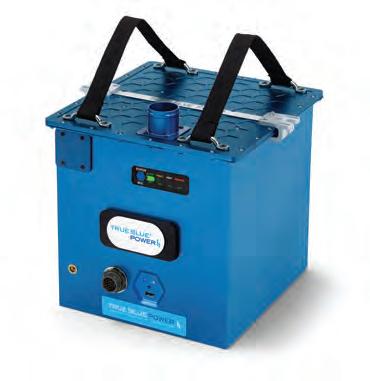
Approvals are due next year for various Bombardier and Gulfstream models.
STCs provide the opportunity for business jet operators to maximize aircraft availability, reliability, and income-earning potential. Built to last, we’re backing our STC Kit with an extended four-year warranty.” z


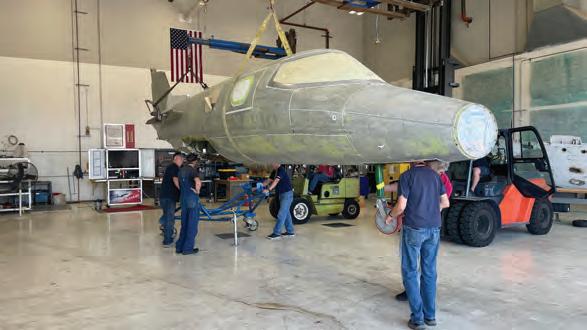
Restoration of the first production Lear 23 continues at Bombardier’s former Learjet delivery facility in Wichita, where a group of volunteers shepherds the painstaking process.
By Curt Epstein
Classic Lear Jet Foundation, the nonprofit group working to return the first production Lear Jet to flight status, is appearing this week at NBAA-BACE at the booth of corporate sponsor Spectro Jet-Care. Notably, they are bringing along a special guest today—legendary Learjet pilot Clay Lacy will be at the booth from 1 p.m. to 2:30 p.m. for a meet-and-greet.
In addition to Lacy’s impressive airline resume and other record-setting aviation achievements, he has vast experience with the early Learjets. In 1964, he flew one of the first Learjet 23s into California’s Van Nuys Airport (KVNY), making it the first corporate jet based there.
Four years later, he founded Clay Lacy Aviation as the first jet charter and executive jet management company on the West Coast. Lacy flew countless Hollywood luminaries in Learjets at the dawn of the private jet era and, in 1965, made a record-breaking daylight flight to New York and back in the same day. At the FBO that bears his name at KVNY, that same Learjet 23—the 12th to roll o ff the assembly line—has been preserved and is on display.
Given his direct history with the type, Lacy was instrumental in the foundation’s purchase
of Learjet 23-003. He personally provided funding as a primary acquisition sponsor that allowed the foundation to become the sole owner of the aircraft in 2023 and begin the restoration process.
The work is being conducted in Wichita in space donated by Bombardier at the former Learjet delivery facility by a group of volunteers, including retired Learjet employees who worked on the assembly line. It’s estimated that the foundation has reached 1,500 total man-hours worked since the project began.
A number of business aviation companies— including Spectro Jet-Care, which provides expertise in fluid and debris analysis as well as engine trend monitoring—have pledged their support for the project by offering free or reduced-cost services.
Work has been progressing on the light twinjet, which recently had its paint stripped off in preparation for non-destructive inspection, tests that will be crucial in determining the scope of the project. Any issues such as corrosion on the skins and stringers will be repaired. The group is currently preparing to do a pressure check of the righthand wing infrastructure in search of leaks. Those results, weighted with the corrosion found on the left wing, will help determine whether the wing unit is salvageable or if it must be replaced. z
Aircraft Specialties Inc. (ASI) has introduced ultrasonic testing to its non-destructive testing (NDT) capabilities. An FAA-approved Part 145 repair station, ASI is based in Omaha, Nebraska, and specializes in repair, overhaul, and exchange of wheels and brakes, NDT services, machining, and advanced cold spray repair techniques. It also distributes specialty aviation products and parts made using the parts manufacturer approval (PMA) process.
Now available from ASI are PM Research FAA-PMA-approved radome boots, leading-edge tape, and protection kits “designed to shield aircraft from erosion caused by environmental elements, reducing costly repairs, and extending component life,” according to ASI. Technicians use Gripedge tools to prevent stripping of fasteners during removal and to remove already damaged fasteners, thanks to the tools’ Rounding Prevention Technology features.
The ultrasonic NDT “uses high-frequency sound waves to detect internal flaws, cracks, or material inconsistencies in aircraft components without causing damage.” This capability complies with component maintenance manual standards.
“These additions reflect our dedication to investing in both advanced technologies and high-quality products that directly benefit our customers,” said v-p of sales Gene Portela. “From PM Research and Gripedge tools to ultrasonic testing, ASI continues to strengthen its role as a trusted partner in aviation maintenance.” M.T.
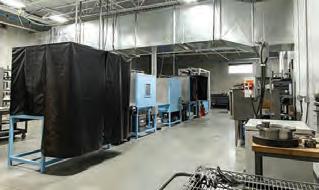
The FAA approved the Cessna Citation CJ3 Gen2 and M2 Gen2 with Garmin autothrottle.
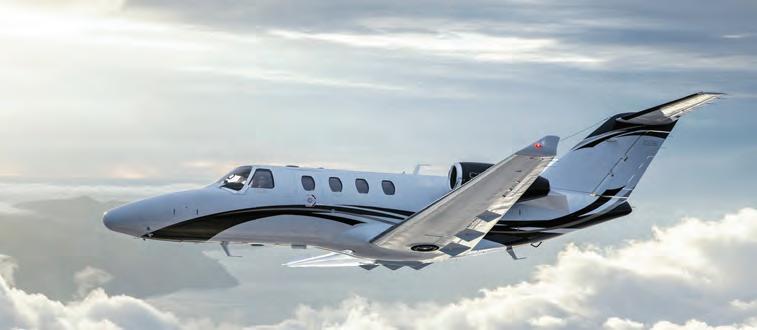
By Kerry Lynch
Textron Aviation has received its next round of FAA approvals for its “Gen” series of aircraft— the Cessna Citation CJ3 Gen2 and M2 Gen2 with Garmin autothrottles—the company said yesterday at NBAA-BACE 2025. These are part of an ambitious schedule of Gen upgrades that the Wichita manufacturer has undertaken for its M2/ CJ series, with Gen3 versions on pace to follow shortly after the latest round of Gen2 approvals.
Following 445 flight-test hours, the CJ3 approval brings “the most comprehensive Citation Gen2 investment to market,” Textron Aviation said, adding that the aircraft is expected to enter service this year.
The Gen2 upgrade features autothrottles integrated in the Garmin 3000 software suite, an additional 4.5 inches of pilot legroom, and a fully customizable cabin. Along with the autothrottles, Textron Aviation is offering an optional enhanced vision system to improve situational awareness.
With a touchscreen interface, the Gen2 incorporates a GDL60 datalink for aircraft connectivity, providing for remote transmission of flight plans, automatic database updates, and wireless transmission of aircraft diagnostic data.
As for the eight- to nine-passenger interior, customers can tailor the cabin for their missions, including seats with tracking capability on the base and floor and optional swivel functionality.
Features include RGB accent lighting for further customization and USB-C power at every seat, along with wireless charging.
Textron Aviation is offering an optional high-power outlet for a coffee machine, ice and trash storage, and the incorporation of a cabin master control switch panel. Another new feature is CoolView skylights in the lavatory and an optional sink and vanity design with a dedicated water supply. The CJ3 Gen2 includes an externally serviceable lavatory, a new feature for the model.
Powered by Williams FJ44-3A turbofan engines, the aircraft has a maximum range of 2,040 nm and a useful payload of 5,530 pounds.
Also equipped with Garmin G3000 avionics, the latest M2 Gen2 approval brings autothrottles to Textron Aviation’s smallest jet, enabling greater control and precision for pilots, optimizing power of the Williams FJ44-1AP-21 turbofans, simplifying flight management, and increasing overall operating efficiency. Garmin’s autothrottles include features to prevent exceedance conditions and alert pilots if any deviations occur.
Certification was the culmination of nearly 300 flight-test hours and numerous certification tests on the M2 Gen2. “Achieving FAA certification for the Citation M2 Gen2 with Garmin Autothrottles reinforces our commitme nt to bringing innovation and industry-leading technology to our customers,”
said Chris Hearne, senior v-p of engineering and programs. “Textron Aviation leads the industry in bringing clean-sheet aircraft and product upgrades to market—certifying nine business jets since 2013.”
When enabled at 400 feet above ground, the autothrottles manage aircraft speed, engine performance, and power, enabling the aircraft to climb, descend, or maintain altitude. This will provide for smoother and more predictable flight profiles, Textron Aviation added.
Certified in April 2022, the M2 Gen2 is equipped with upgraded interior styling, ambient accent lighting, illuminated cupholders, and an optional folding side-facing seat that converts into additional cargo storage. In addition, the seven-passenger cabin incorporates wireless charging capabilities and USB-A and -C ports at each cabin seat. Textron Aviation added 3 inches of legroom to the copilot position in the cockpit.
Designed for single-pilot operations, the 404-knot light jet has a maximum range of 1,550 nm, can operate with runways as short as 3,210 feet, and can reach an altitude of 41,000 feet in 24 minutes.
In addition to the CJ3 and M2 Gen2 variants, Textron Aviation had certified the CJ4 Gen2 in 2021. But work is continuing on the next iterations of these models, with Gen3 versions announced during NBAA-BACE in 2024. The CJ4 Gen3 will feature Garmin’s new G3000 Prime touchscreen avionics suite and other refinements, and the M2 Gen3 and CJ3 Gen3 will have Garmin Autoland. Certification for the updates is anticipated next year.
Briefing reporters on the updates ahead of NBAA-BACE, Cessna senior v-p of sales and marketing Lannie O’Bannion stressed that many of these upgrades reflect many of the requests of the customer advisory board. He cited as an example owner-operators seeking more legroom in the cockpit of the CJ3 so now it has 4.5 more inches, “which makes that experience while flying the aircraft much better.”
Noting that Textron Aviation is launching the G3000 Prime on the CJ4, he said that unveiling “really stole the show last year.”
Textron Aviation brought the CJ3 Gen2 cabin mockup to NBAA-BACE, along with the CJ4 Gen2, Citation Latitude, Citation Longitude, and the debut of the Citation Ascend. z
Camp’s AI tool analyzes aircraft history and operational patterns to help maintenance facilities plan more efficiently and avoid unexpected delays.

By Matt Thurber
West Star Aviation is the launch partner for Camp Systems International’s new AI Operations Manager, an artificial intelligence (AI)based predictive intelligence tool for aircraft maintenance facilities that use Camp’s Corridor software.
AI Operations Manager is designed to help MROs address key hurdles that hamper efficiency. West Star will use the AI-based tool for four areas, using data “to plan maintenance visits more effectively, achieve faster turnaround times, provision labor efficiently, and reduce unexpected issues during projects,” according to Camp Systems.
“Automation and AI are ushering in a new era in aviation maintenance,” said Peter Velikin, general manager, Camp enterprise information systems. “With our patented AI models, the AI Operations Manager ensures faster turnarounds, consistent quality, and smarter utilization of assets, all driven by a service center’s own historical ERP data.”
During the past two years, Velikin has been visiting MRO facilities to ask about their challenges and identify areas where AI might help. He believes that AI offers many opportunities for the aviation MRO industry. “One of the things that I am passionate about, and we have made investments in…is the ability and the opportunity
for AI to transform MRO operations,” he said.
Aviation is highly regulated, so putting AI and automation tools to work in the MRO business must be done carefully, Velikin explained. Camp Systems has an advantage in that it has partnerships with all the aircraft OEMs for maintenance tracking programs, and it also works many service centers.
The company is actively working on ways to leverage this experience and the vast amount of data it captures to make sure AI tools are implemented correctly. That said, Camp Systems is careful to segregate owner-generated data from the data it collects from partner MROs.
Of the four core areas that AI Operations Manager addresses, planning is an important element. It is hard for an MRO to budget the time and resources needed for a major inspection, for example, given the unknowns that invariably pop up during the process. “The challenge they run into is that the airplane would land, and they quoted two weeks for repair, and then they realize that there’s other jobs that need to happen that are unscheduled,” Velikin said. Parts might not be in stock, and then when they arrive, the mechanics have already been moved to another job.
MROs deal with this by adding buffers to their estimates, stocking expensive parts, and dealing with problems as they arise. A better way is to use AI to evaluate the airplane’s history, where it flies, and age and condition of parts
to predict what problems are likely to emerge.
“That gives you a lot of opportunities,” he said. “You can be much more confident and aggressive in quoting to the customer and promising a turnaround time. You can prestage parts…and plan for the right mechanics to be there. That optimizes the chain in many ways.”
Another core area is to address quality escapes by mechanics. AI can help with this by ensuring mechanics have information they need related to a particular task. “So, being able to give warnings in cautions to the mechanics as they do certain jobs based on quality escapes,” Velikin said.
This could include providing task-specific training with a video, and experienced mechanics capturing and sharing guidance that will help the next person do the same task. AI is also a powerful assistant when it comes to troubleshooting, he added. “You could be the best at whatever you do, but it is always beneficial to have a trained second [opinion via] AI that can provide a structure and verify [the problem].”
The third area is to use AI-enhanced analytics to evaluate components and provide insights on more efficient pricing of repairs and overhauls. This could eventually include tying customer information with a particular component, to help inform failure modes based on operational data.
“That will be super beneficial,” Velikin said. “Today, I don’t think we’re going that far, because one of the most important things for our customers is that they want to protect the privacy of their own data. I’m optimistic that—I don’t know if it’s the medium-term or long-term— that there will be enough benefit to go there.”
The final area is using AI to gain insights and find correlations from unstructured data, he explained, “and being able to visualize it instantly.”
Where AI proves useful is to spot trends and use that information to optimize the operation and the business. “I believe that the businesses that invest in technology and leverage this ability to react faster will out-compete the laggards,” Velikin said.
“The aviation industry is at an inflection point where predictive technologies will define competitive advantage,” said Camp Systems president and CEO Sean Lanagan. z

Amstat’s improved Premier+ information platform enables tracking of client engagement and provides access to broker collateral, aircraft logbooks, and other materials, as well as integrated links to NTSB damage reports for history checks.
By Curt Epstein
Business aviation data tracker Amstat has introduced several improvements to its Premier+ subscription-based information platform. Included in the added functionality is a secure, branded portal that allows brokers to share aircraft specifications and preowned market reports with their clients. It can also track client engagement for timely follow-up contact.
Changes to the MyMarket capabilities expand the platform’s editing, note-making, and document attachment functions, allowing
users to quickly catch up on active markets, while upgrades to the AI-driven aircraft valuation tool automatically log estimated values for aircraft transactions, providing a historical snapshot and the ability to track value trends for specific aircraft serial numbers.
Users can now request an easy-to-share market overview to more e ff ectively communicate with customers, and the system o ff ers access to broker collateral, aircraft logbooks, and other materials, as well as integrated links to NTSB damage reports for history checks. The company will demonstrate
these new capabilities later this month at NBAA-BACE.
Unchanged are features such as the StatPak presentation developer, the sanctioned aircraft list to avoid high-risk assets, company fleet metrics, customizable territories, and global flight data.
“Amstat was founded to support aircraft brokers and their research teams,” said general manager Andrew Young. “These new features build on decades of experience delivering the data and tools that fuel broker sales activity and streamline research.” z
German business aviation services group Aero-Dienst has established a U.S. subsidiary in Palm Beach, Florida, focused on supplying spare parts, it announced this week at NBAABACE 2025.
In mid-2026, the new Aero-Dienst America subsidiary will expand its portfolio, and in the long-term this could extend to opening an MRO facility in the U.S. According to the group, services could include technical support for aircraft transactions, such as helping customers to disassemble valuable components for repair,
recertification, and resale, as well as conducting pre-purchase inspections across North America.
“We are expanding our service portfolio step by step in response to customer needs,” Matthias Mößner, CEO of Aero-Dienst America, told AIN. “While our immediate focus is on parts distribution, consulting, and specialized services such as aircraft detailing, the establishment of an MRO facility in the U.S. remains a strategic option for the future. We see potential for a high-quality, European-standard MRO operation in select U.S. markets.”
While the German company continues to monitor issues around possible U.S. import tari s, Aero-Dienst indicated that these are not the primary motivator for establishing the facility in Palm Beach. “Establishing a U.S. presence allows us to operate closer to the source, improve lead times, and achieve more competitive pricing for our customers worldwide,” Mößner said. From its Nuremberg headquarters, Aero-Dienst provides MRO support for multiple aircraft and engine types, including Bombardier and Dassault Falcon business jets. C.A.
The Bombardier Global 7500, and its Model 8000 successor, can access 30% more airports in real-world conditions than its “closest competitor in speed and range,” Bombardier sales engineer Melissa Giannangelo told AIN. While she demurred on naming that competitor, the Gulfstream G700 is the only in-service aircraft that meets this definition.
Typically, the company’s sales engineering team works one-on-one with customers—current and potential—to crunch the numbers to see if a specific Bombardier jet can operate at a certain airport. But the marketing team asked for a broader look at the Global 7500’s airport operating capability versus the closest competition.
The project started with an analysis of more than 13,000 airports worldwide. Then the sales engineering team further narrowed it down to airports with runways exceeding 3,500 feet and elevation up to 8,000 feet msl, resulting in 6,500 airports where the Global 7500 could land under typical wind conditions, dry runways, and stopping on 60% of available length (i.e., FAA Part 135 operating
continued from page 1
“We did that because this is an area where we really haven’t been before, and so that validated our models.” That actually let us have total confidence and then bring the certification authorities and the regulators along to this new speed of 0.95.”
This increased speed was revealed shortly before the aircraft was anticipated to receive Transport Canada approval, and McCullough said this has been “full steam ahead.” Certification is expected in the upcoming weeks, with the first delivery by year-end. Martel said that the first customer will be announced at the time of delivery.
In tandem with speed and range, Bombardier maintains that the Global 7500/8000 fourzone aircraft brings runway performance comparable to smaller jets, able to access 30% more airports than rival aircraft (see above story).
In addition to boosting the speed, Bombardier also revealed that it will hand over
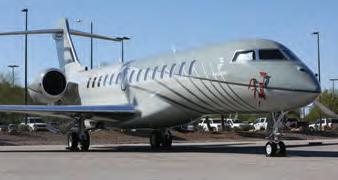
limitations). These include 2,500 airports in the U.S., 950 in Europe, 800 in Latin America, and 2,250 in the rest of the world.
JAMES HOLAHAN (1921-2015), FOUNDING EDITOR
WILSON S. LEACH, FOUNDER & CHAIR EMERITUS
EDITOR-IN-CHIEF – Matt Thurber
MANAGING EDITOR – Charles Alcock
PRESS ROOM EDITOR – Chad Trautvetter
PRESS ROOM MANAGING EDITOR – Jessica Reed
THE EDITORIAL TEAM - Charlotte Bailey, Curt Epstein, Kerry Lynch, Hanneke, Amy Wilder
PRODUCTION MANAGER – Martha Jercinovich
GRAPHIC DESIGNERS – Grzegorz Rzekos
PHOTOGRAPHERS – Barry Ambrose, Mariano Rosales
DIRECTOR OF VIDEO – Ian Whelan
EXECUTIVE CHAIR – Dave Leach
PRESIDENT – Ruben Kempeneer
HEAD OF PEOPLE & BRAND – Jennifer Leach English
SENIOR DIRECTOR EVENTS – Nancy O’Brien
ADVERTISING SALES
DIRECTOR OF SALES - Henry Specht
Victoria Tod – Northeastern U.S./Eastern Canada/United Kingdom, +1 (203) 733-4184
Michelle James – Western U.S./Western Canada, +1 (520) 343-0236
Joe Rosone – Midwestern U.S., Southeastern U.S./Caribbean/ Brazil, +1 (301) 693-4687
C.T.
Instead of calculating data airport-byairport, the company wrote Python code to automatically plot the airports where the Global 7500 and G700 could land, with airport altitude on the vertical axis and available landing distance on the horizontal axis. The data bifurcated between the two aircraft at about 5,000-foot runway lengths, with the Global 7500 able to land on runways as short as about 3,800 feet, including a 40% safety margin and dry conditions with wind. This results in the Global 7500 having about a 30% runway performance advantage over the G700.

a Global 8000 to business aviation services company Comlux in 2026. “The Bombardier Global 8000 integrates perfectly into our long-range fleet, in between our widebody fleet and our Global 6500 fleet,” said Comlux Aviation CEO Andrea Zanetto. “We have built our reputation on delivering premium global travel solutions, and this aircraft allows us to offer ultra-long range.” z
Diana Scogna – Europe/Middle East, +33 6 62 52 25 47
DIRECTOR MARKETING AND CLIENT SERVICES – Lisa Valladares
AUDIENCE DEVELOPMENT DIRECTOR – Eileen Silberfeld
SOCIAL MEDIA MARKETING – Zach O’Brien
SALES ADMINISTRATOR – Cindy Nesline
MANAGER OF FINANCE & HUMAN RESOURCES – Tracy Britton
ACCOUNTS PAYABLE – Mary Avella
ACCOUNTS RECEIVABLE – Bobbie Bing
U.S. HEADQUARTERS:
214 Franklin Ave., Midland Park, NJ 07432, +1 (201) 444-5075
Advertising Inquiries: +1 (201) 345-0085, adsales@ainonline.com
Circulation Inquiries: +1 (201) 345-0085, subscriptions@ainonline.com
WASHINGTON, D.C. EDITORIAL OFFICE: Kerry Lynch (business aviation) – klynch@ainonline.com +1 (703) 969-9195
EUROPEAN EDITORIAL OFFICE: Charles Alcock – calcock@ainonline.com, Tel: +44 7799 907595
NBAA Convention News is a publication of the AIN Media Group, Inc., 214 Franklin Ave., Midland Park, NJ 07432; Tel.: +1 (201) 444-5075. Copyright © 2025 All rights reserved. Reproduction in whole or in part without permission of AIN Media Group, Inc. is
Save time and money by monitoring the value of your aircraft in 'real-time'.

Subscribers can also:
– Generate a comprehensive list of all aircraft transactions in the last 12 months
– View a detailed photo gallery for your specific aircraft
– Receive a weekly report summarizing market fluctuations



